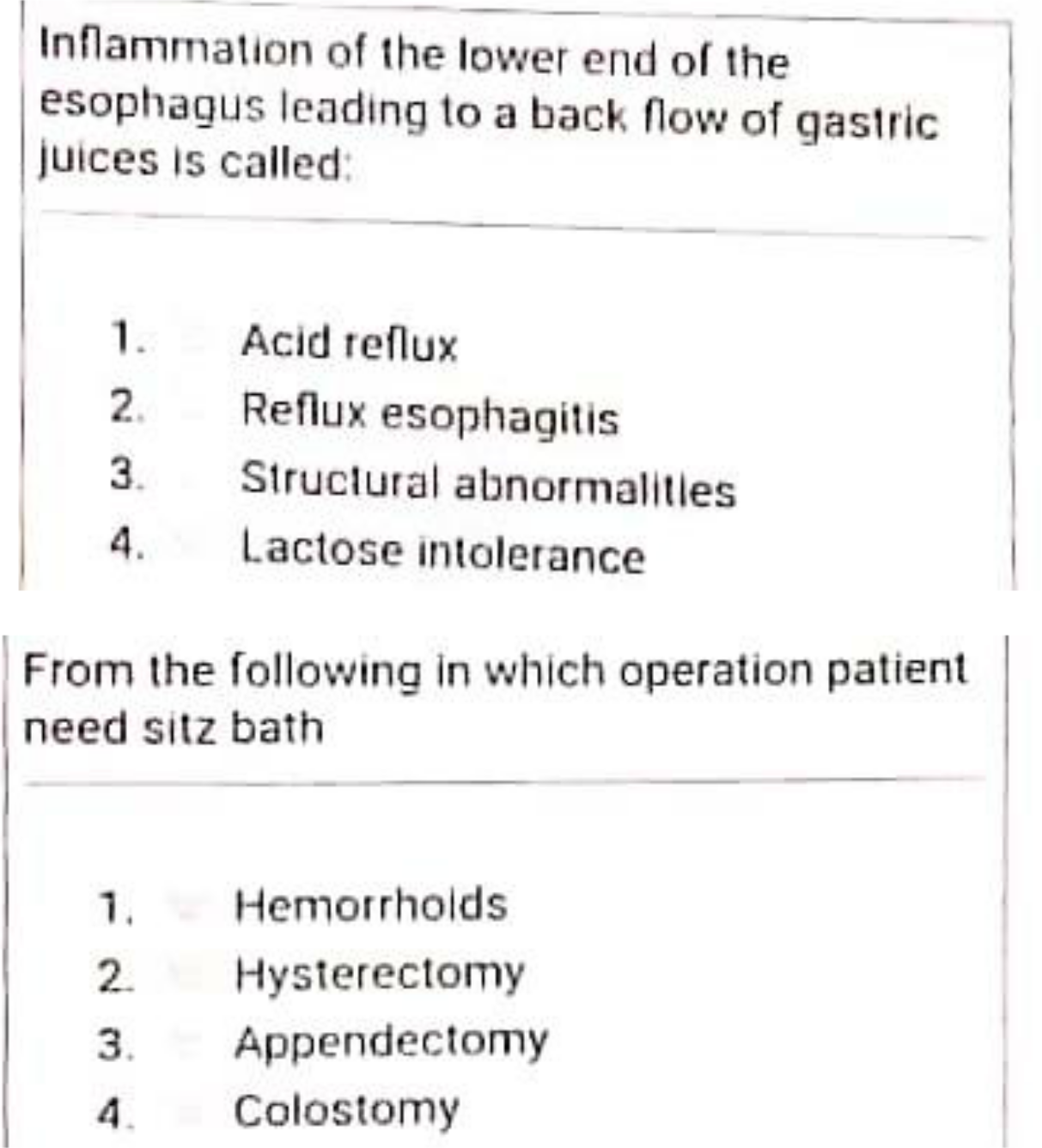
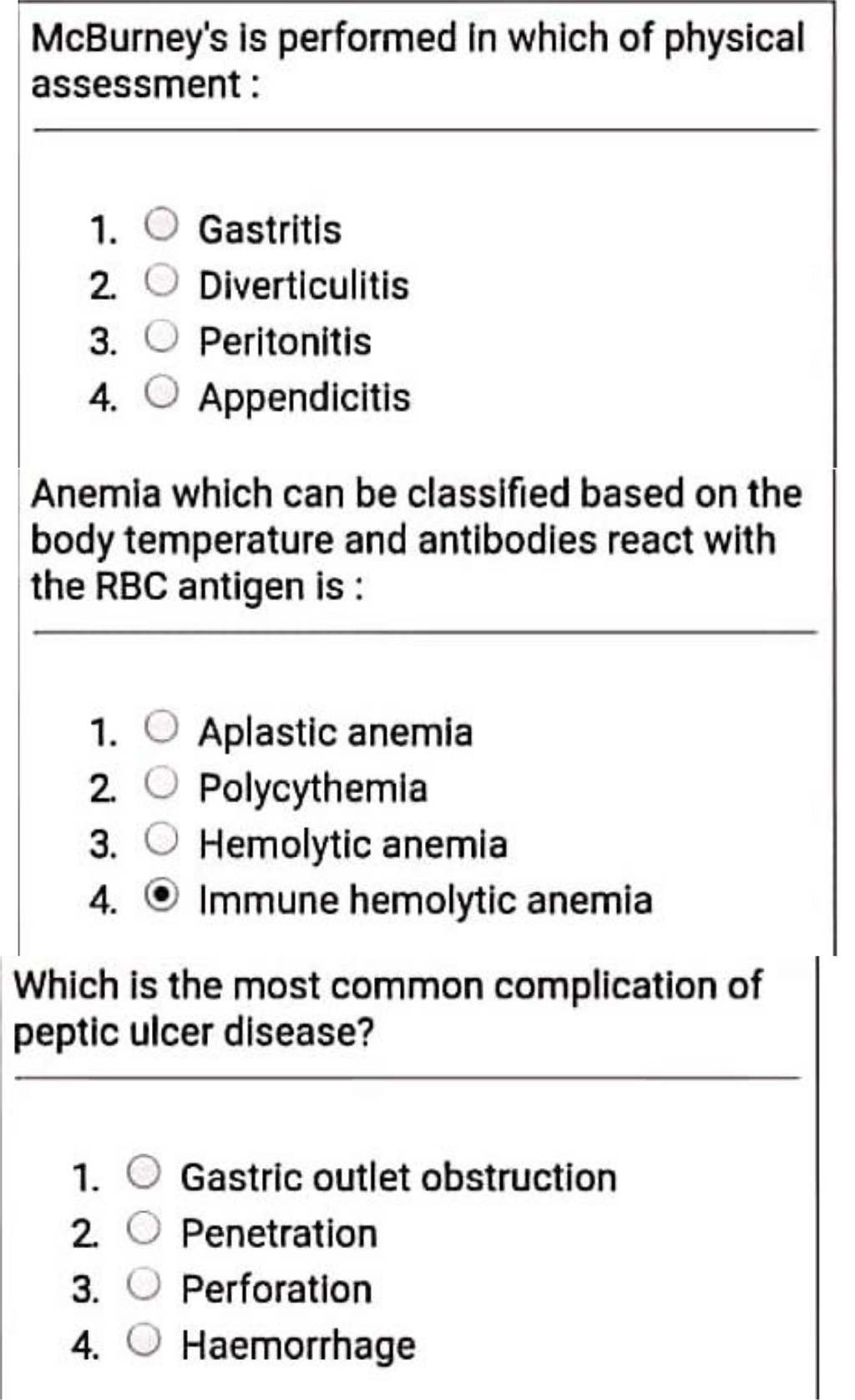
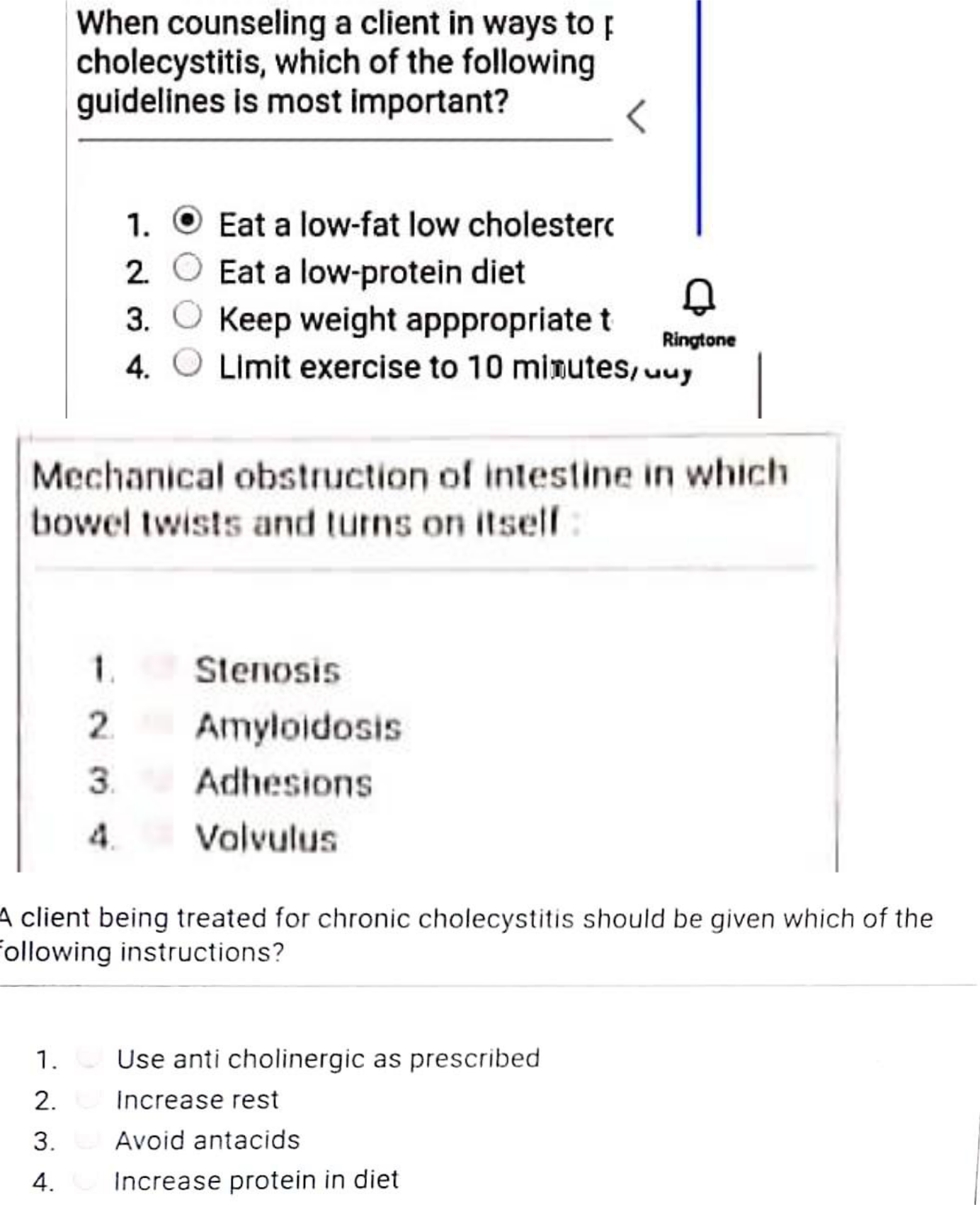
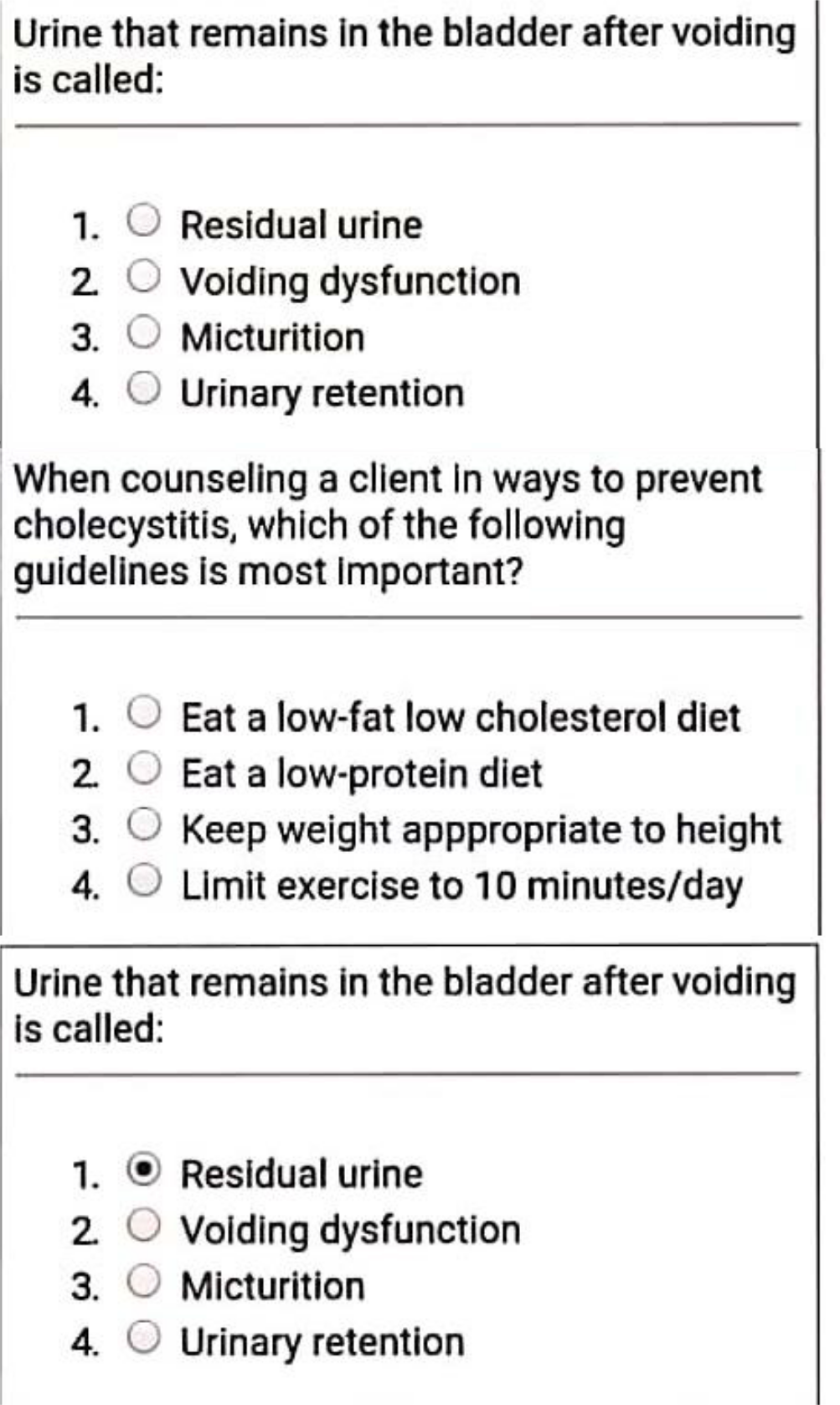
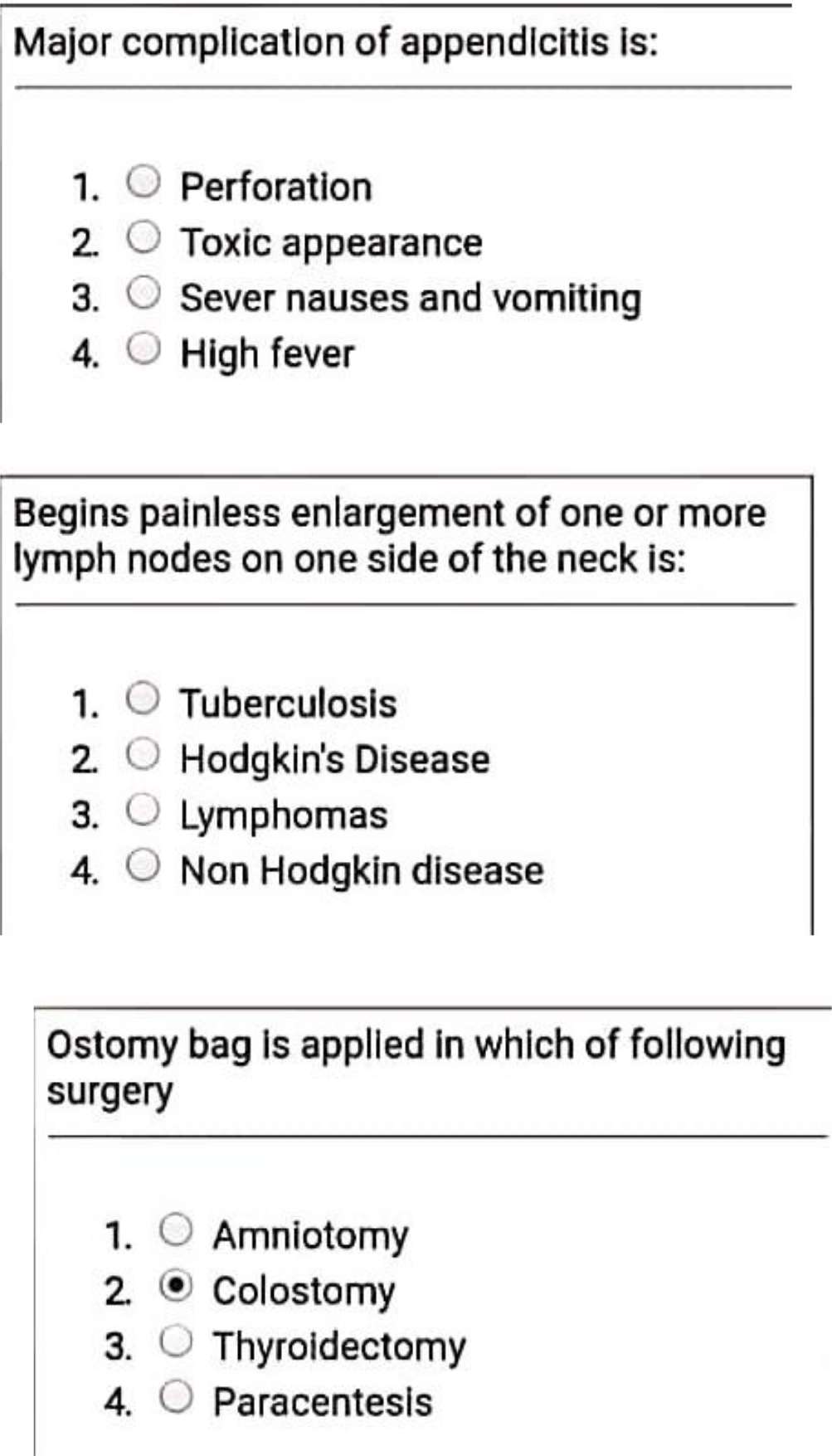
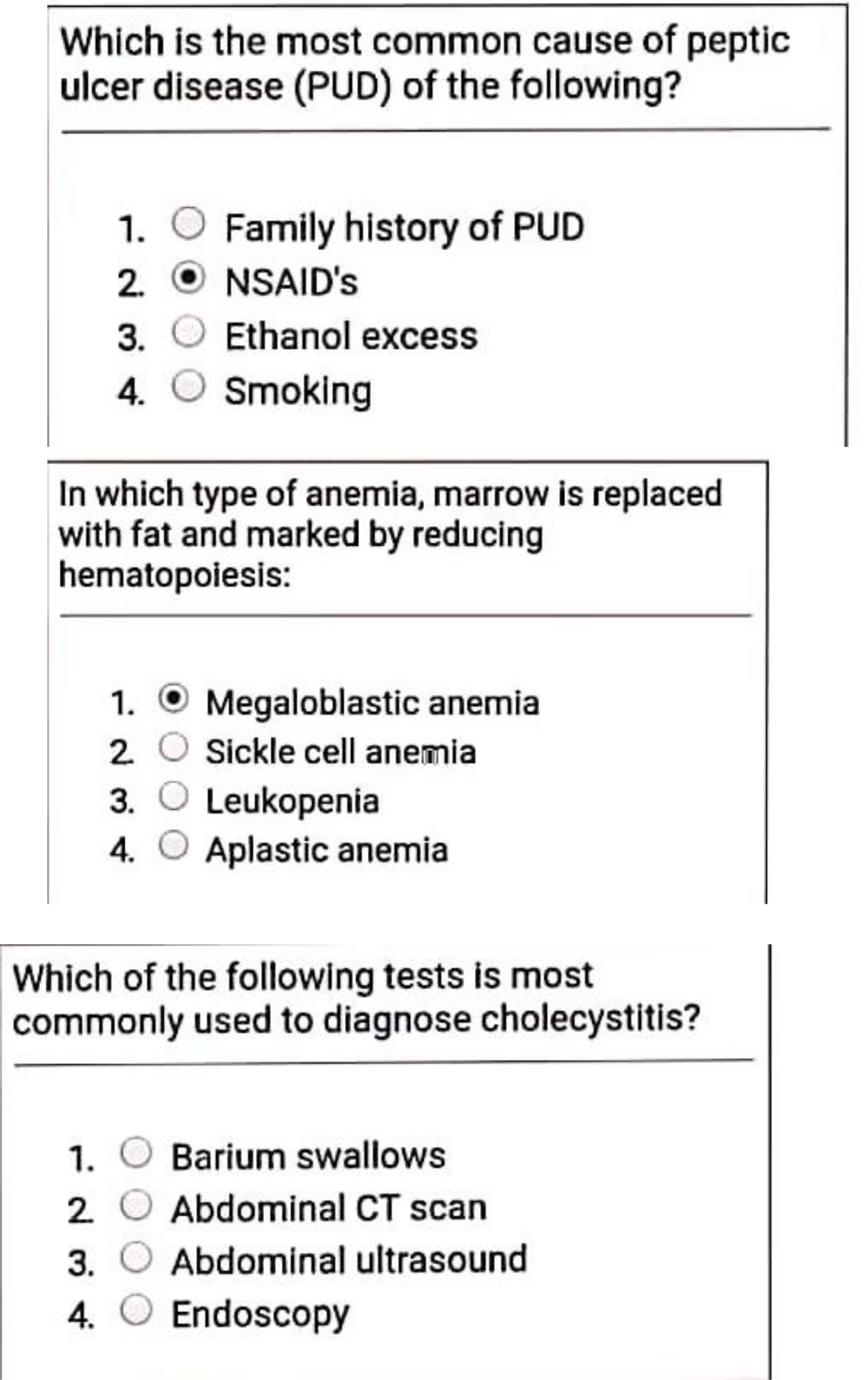
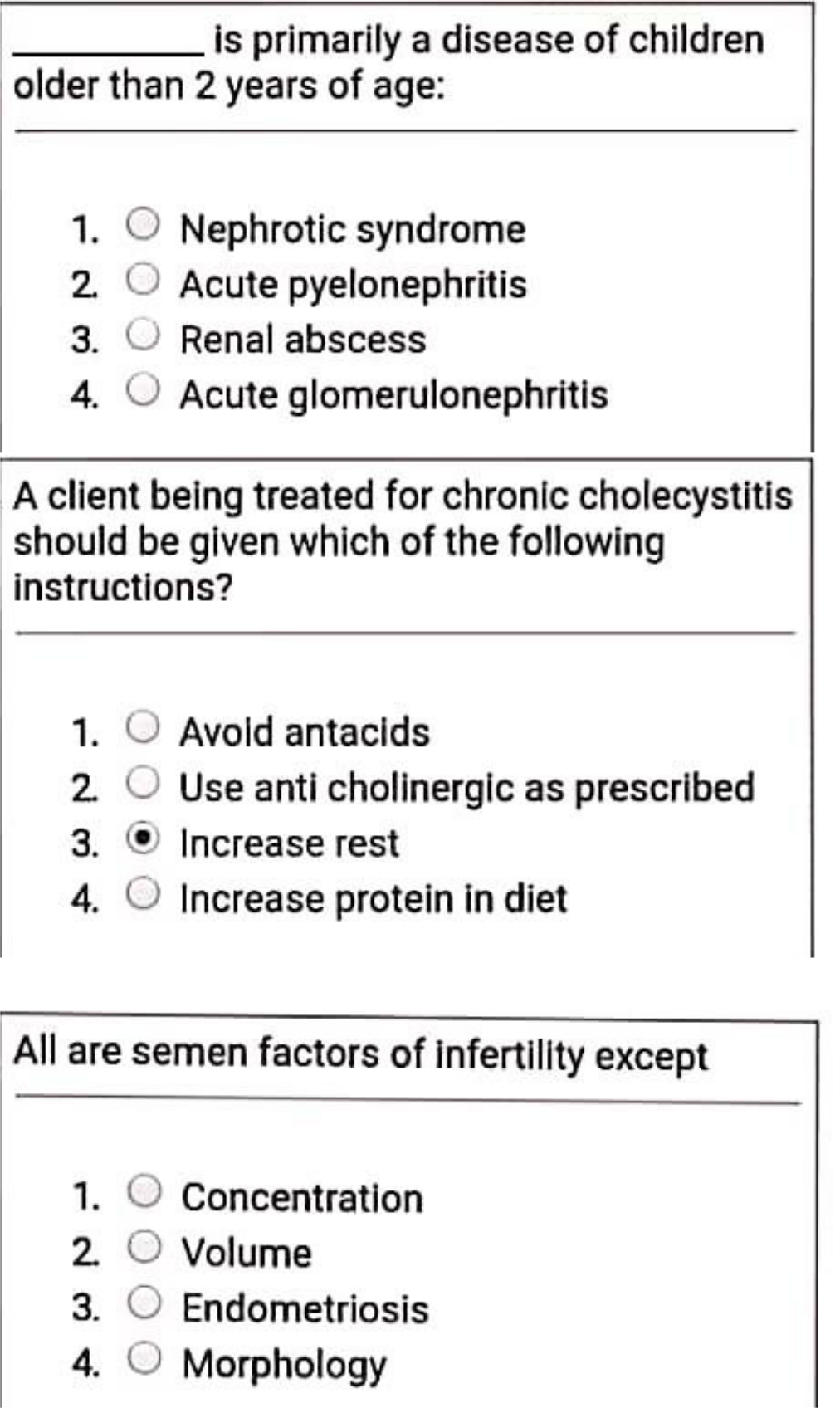
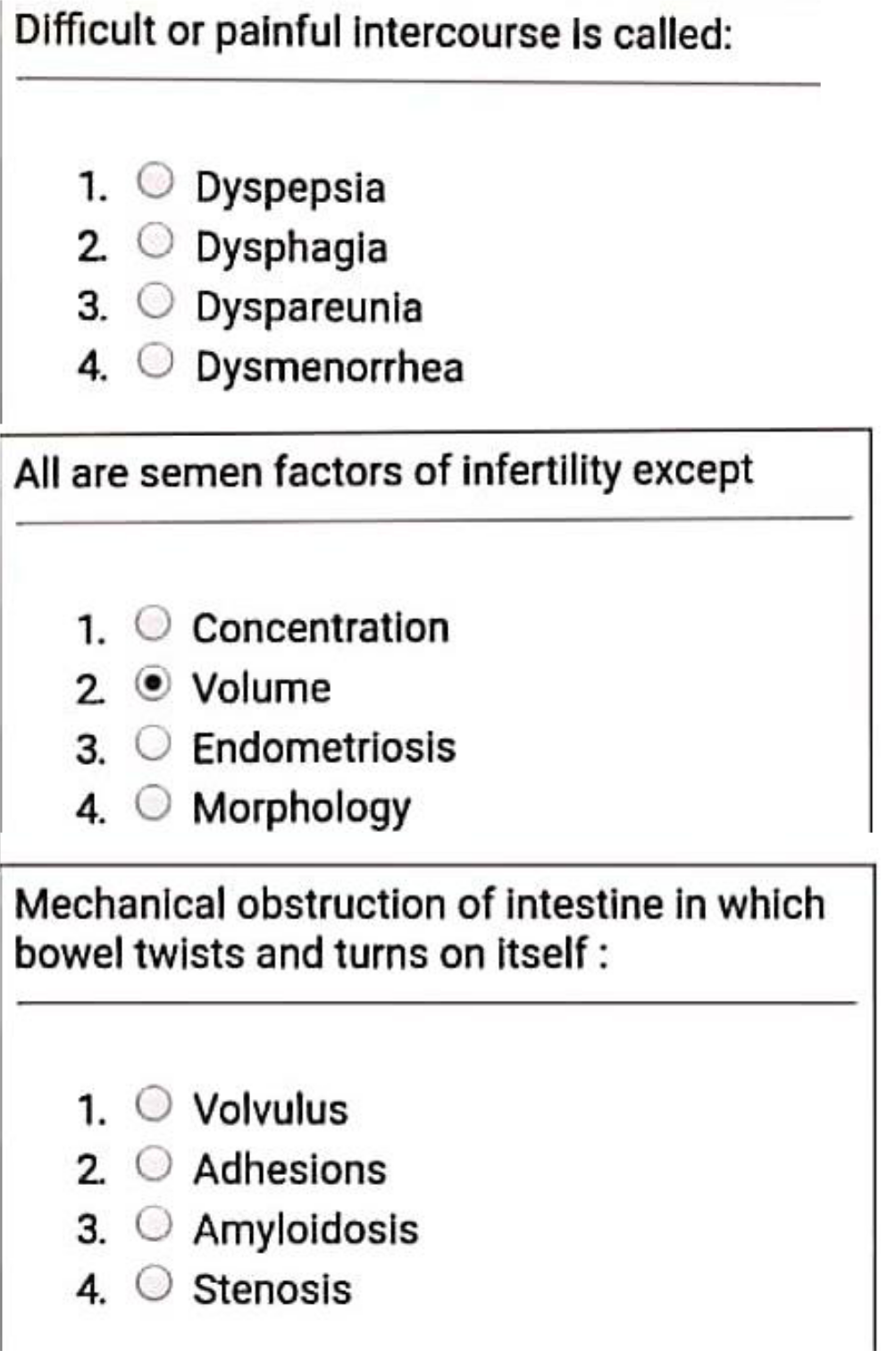

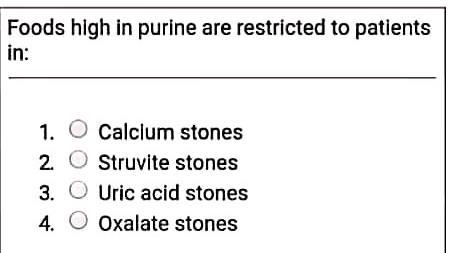
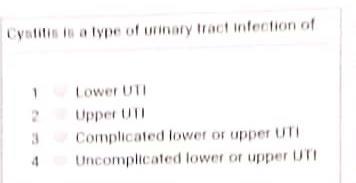
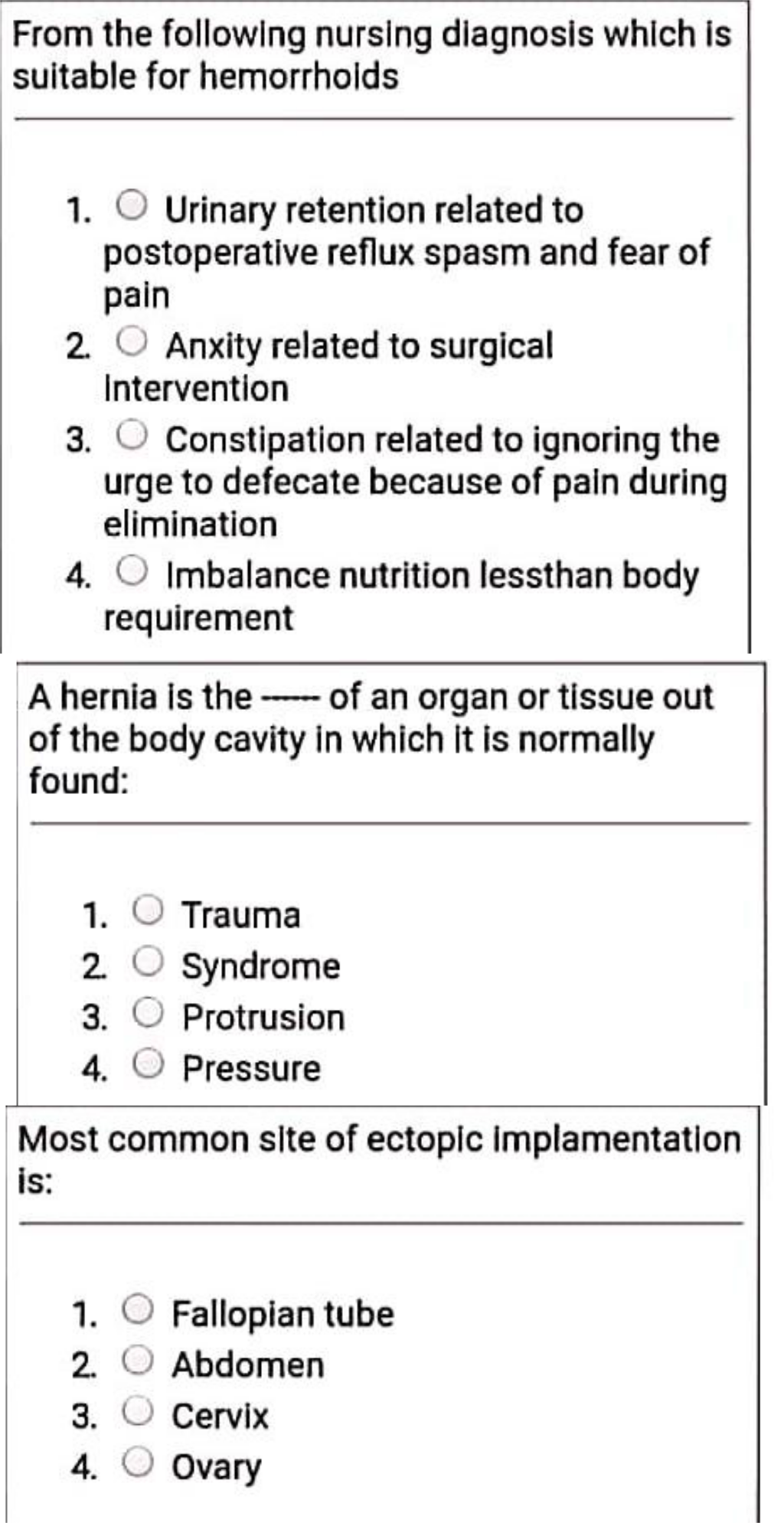
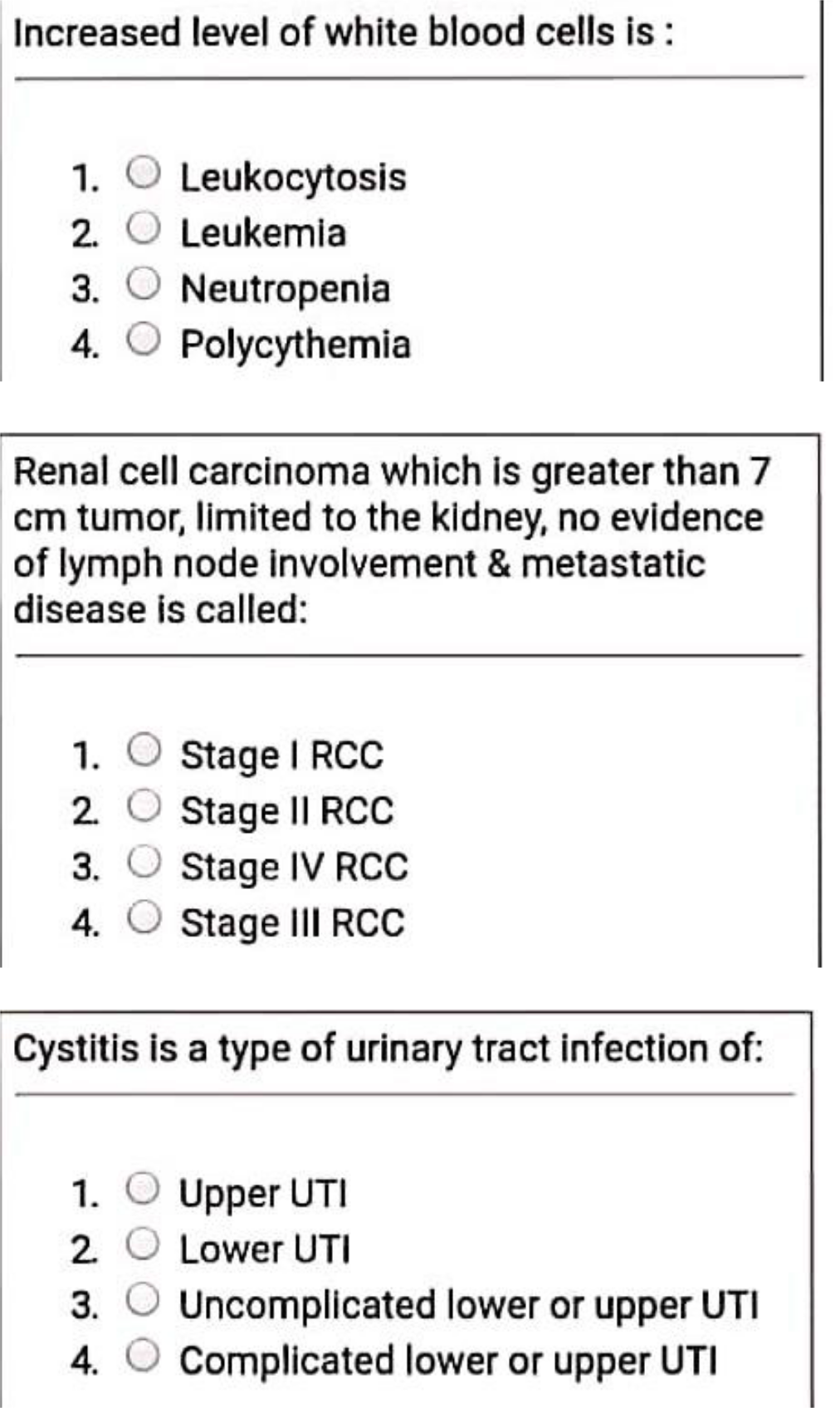
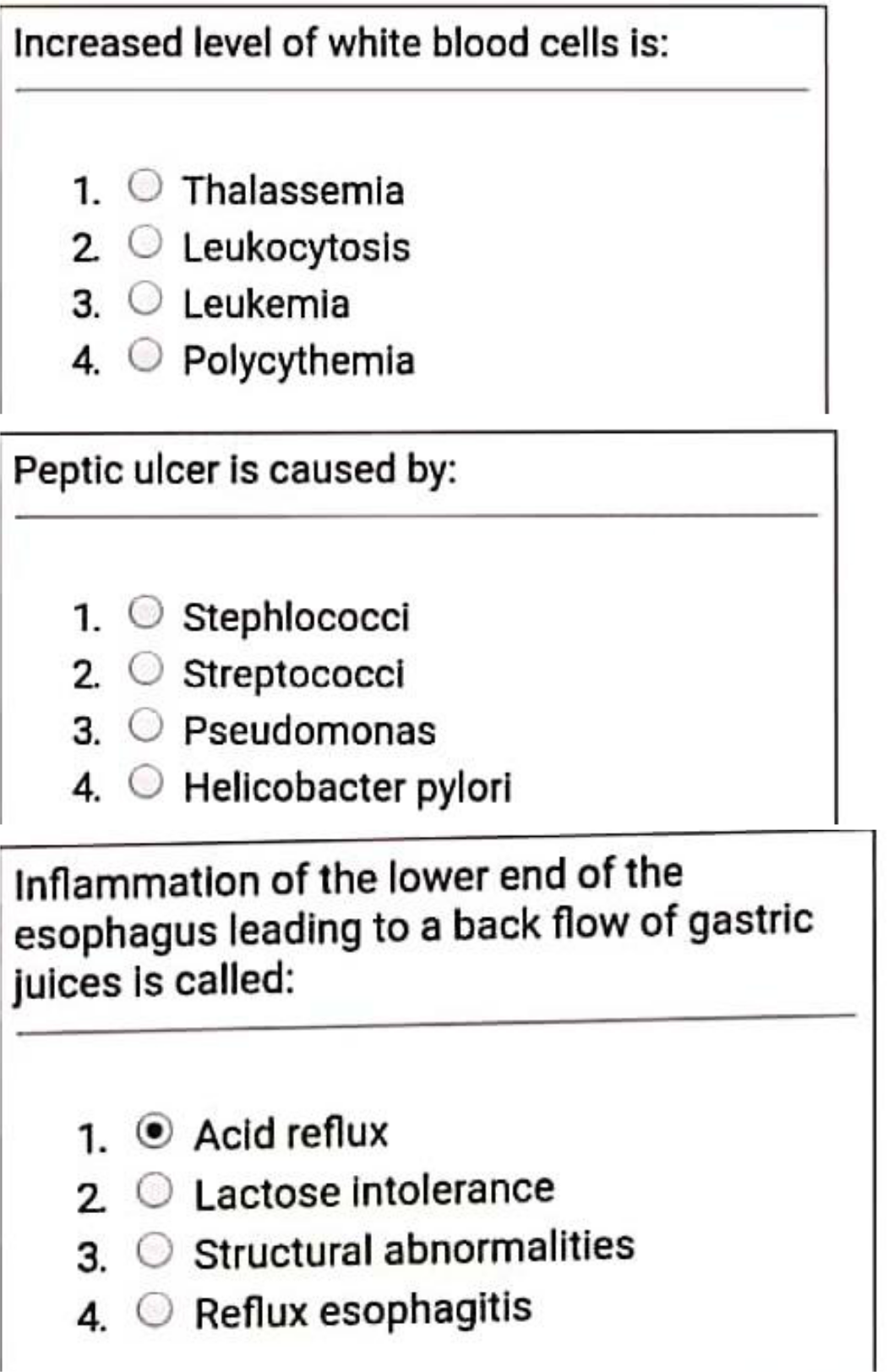
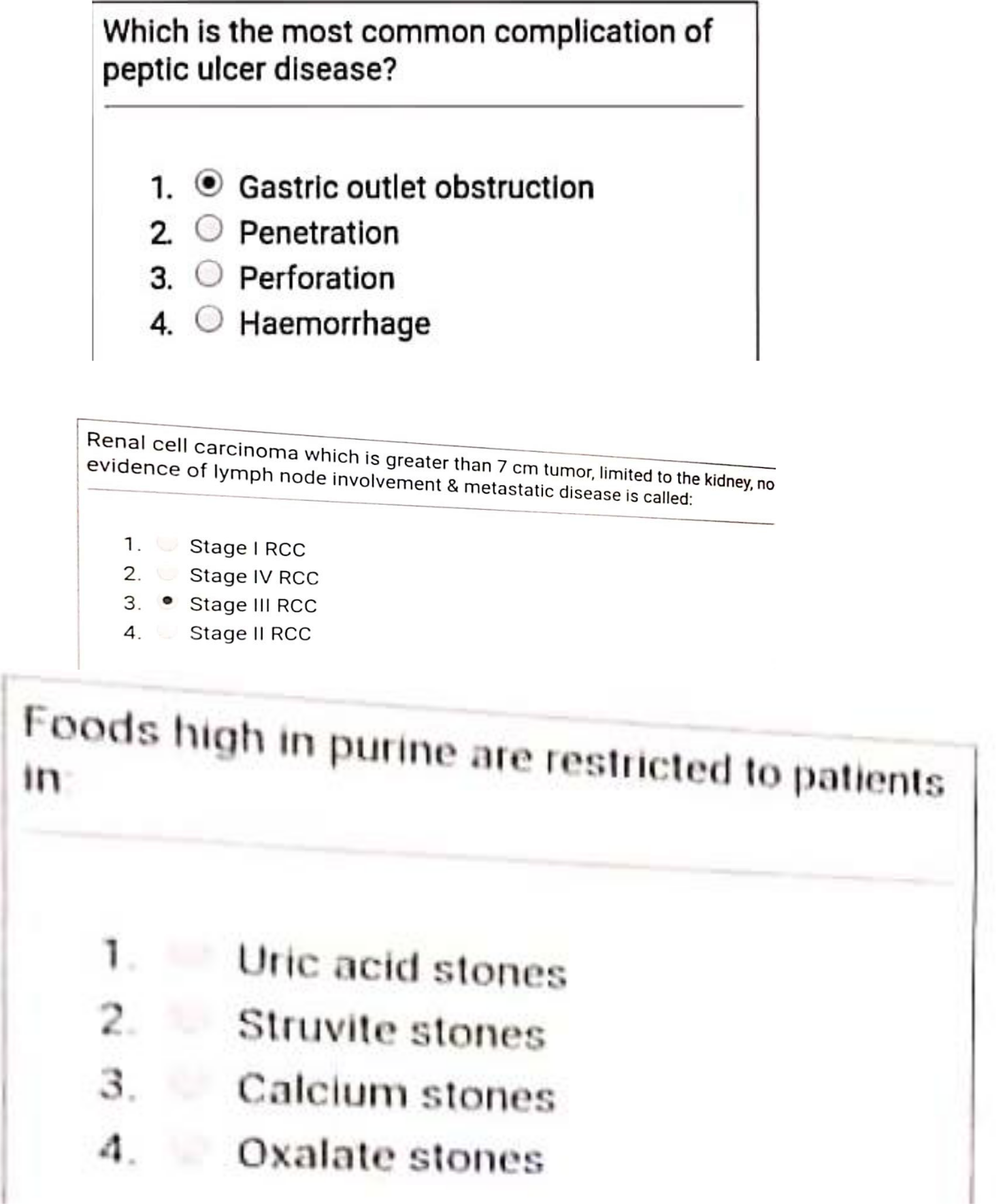
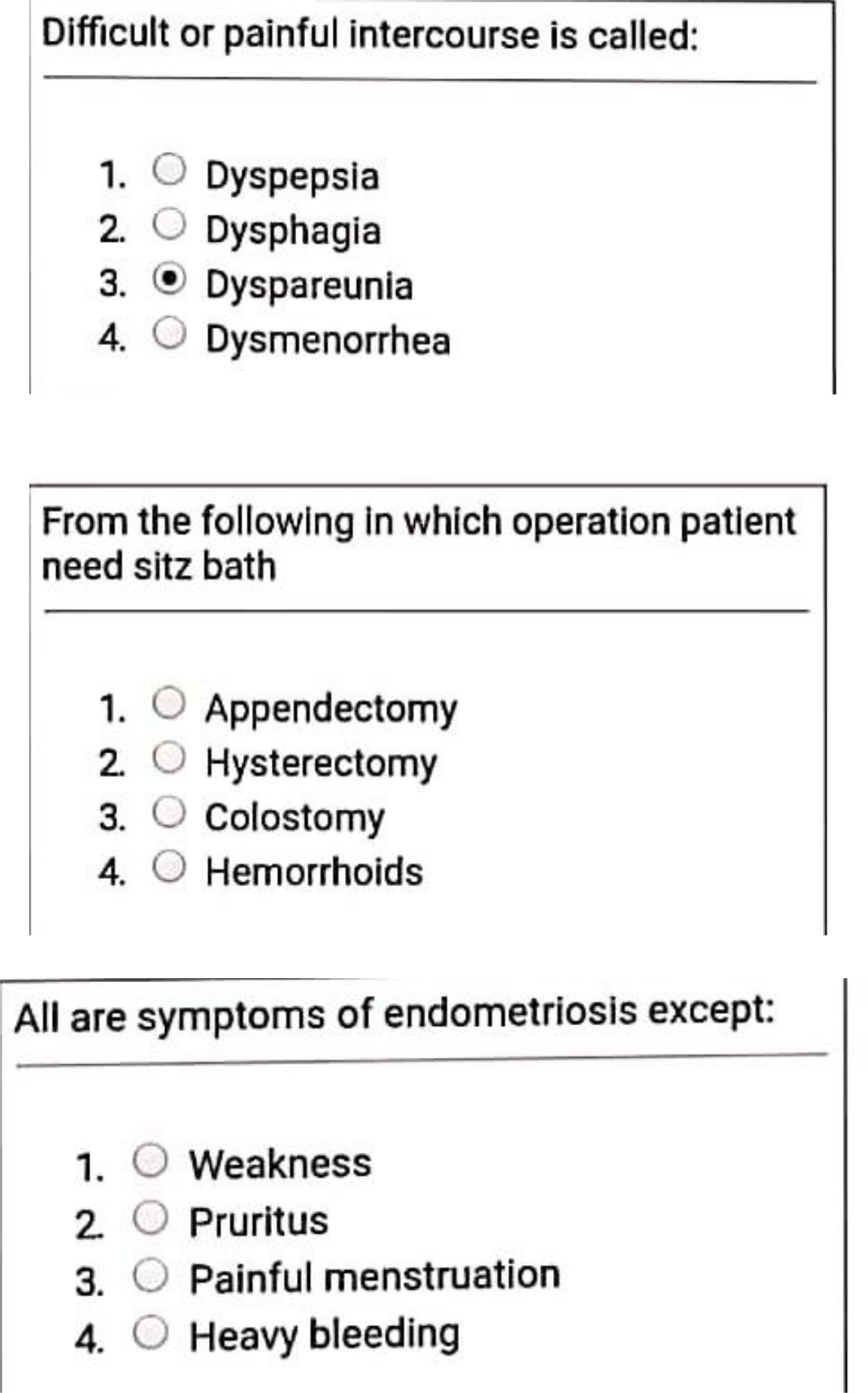
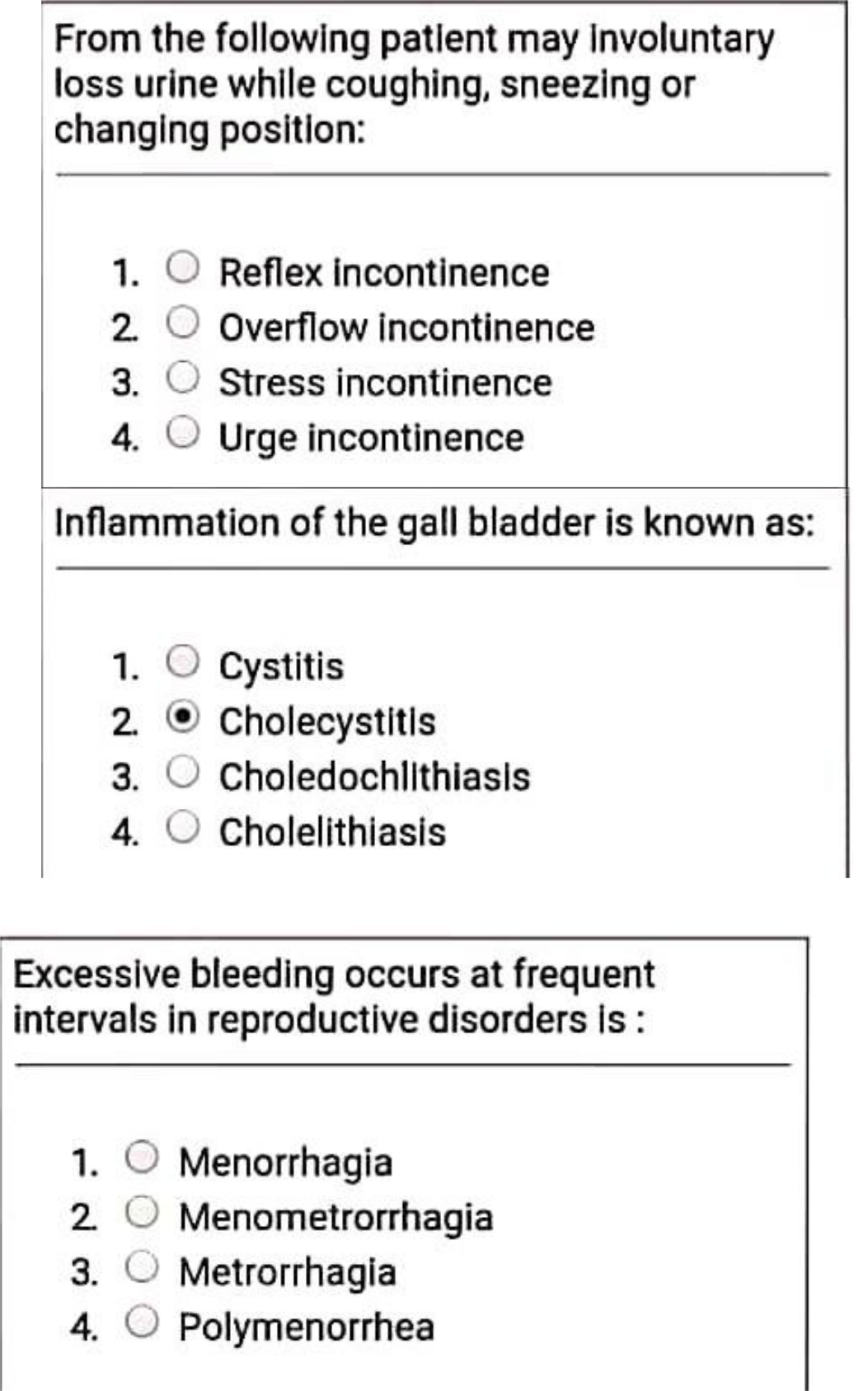
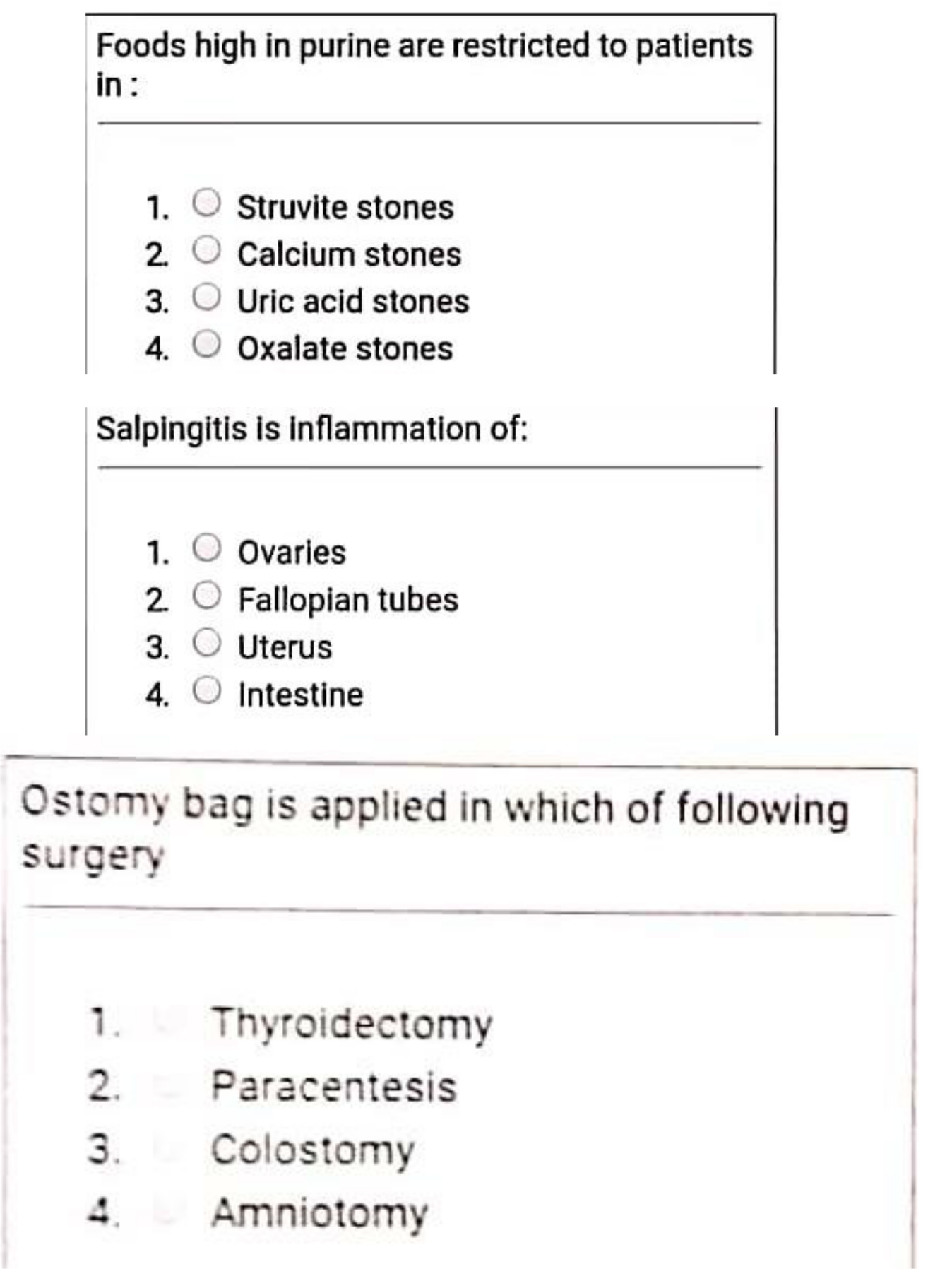
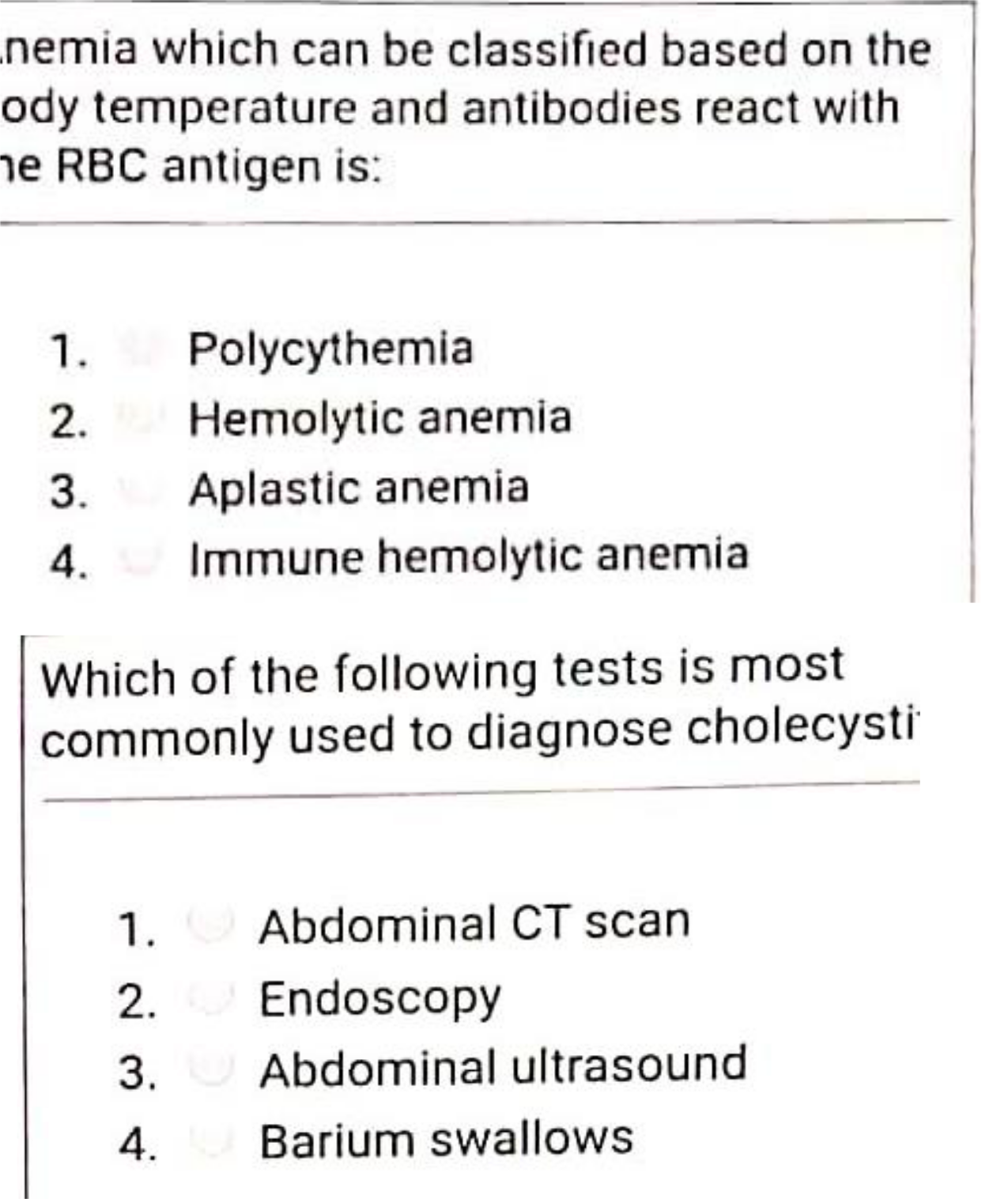
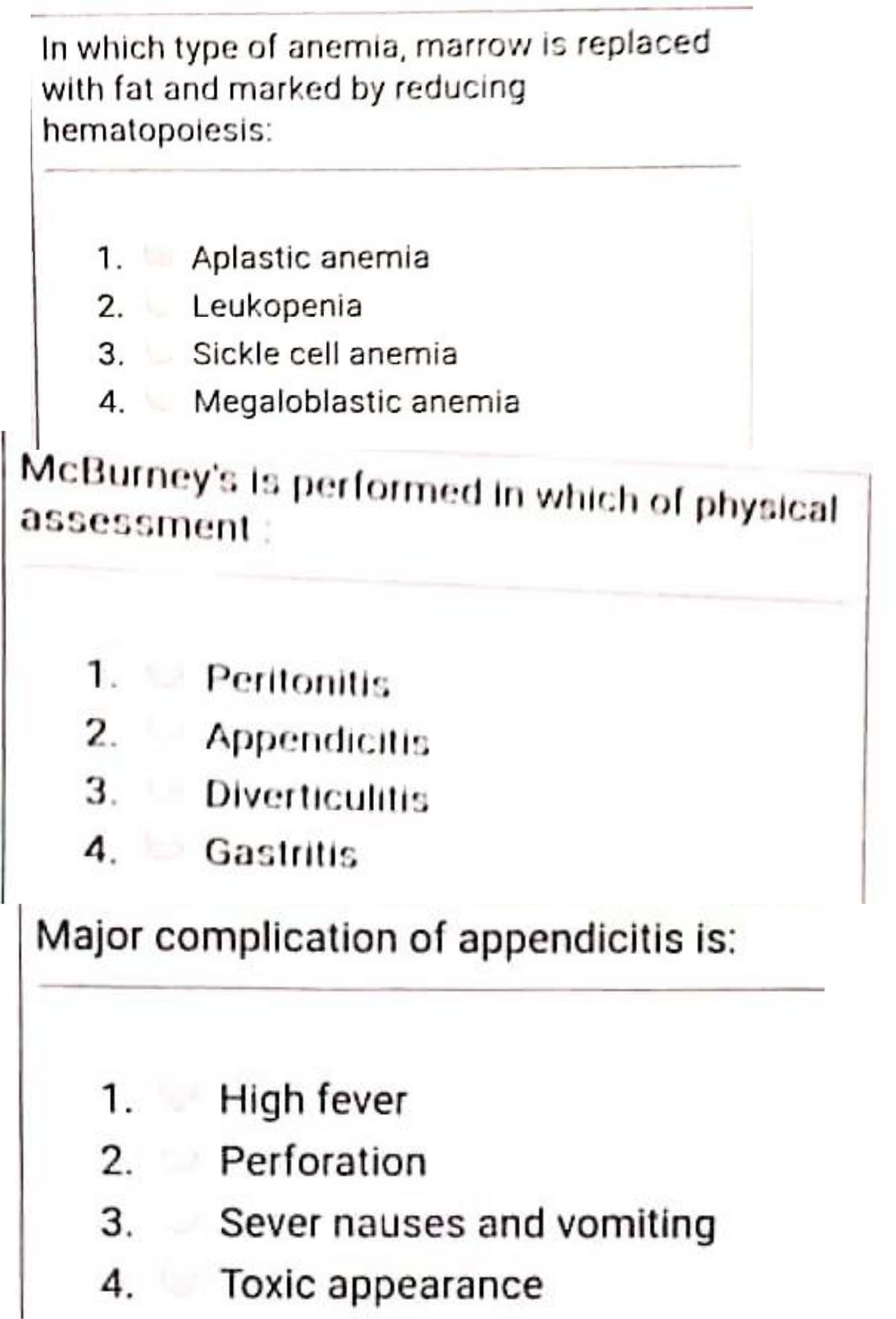
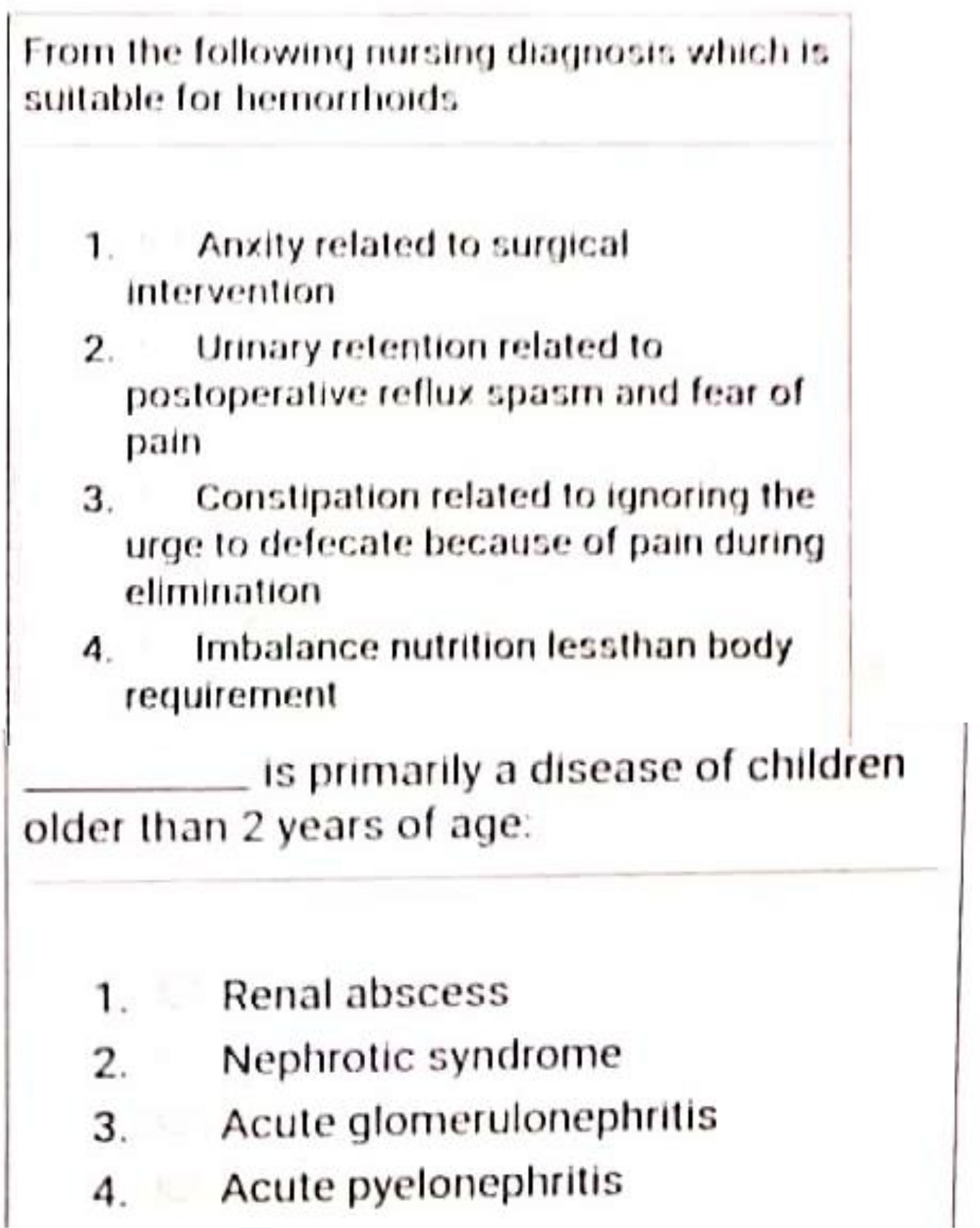
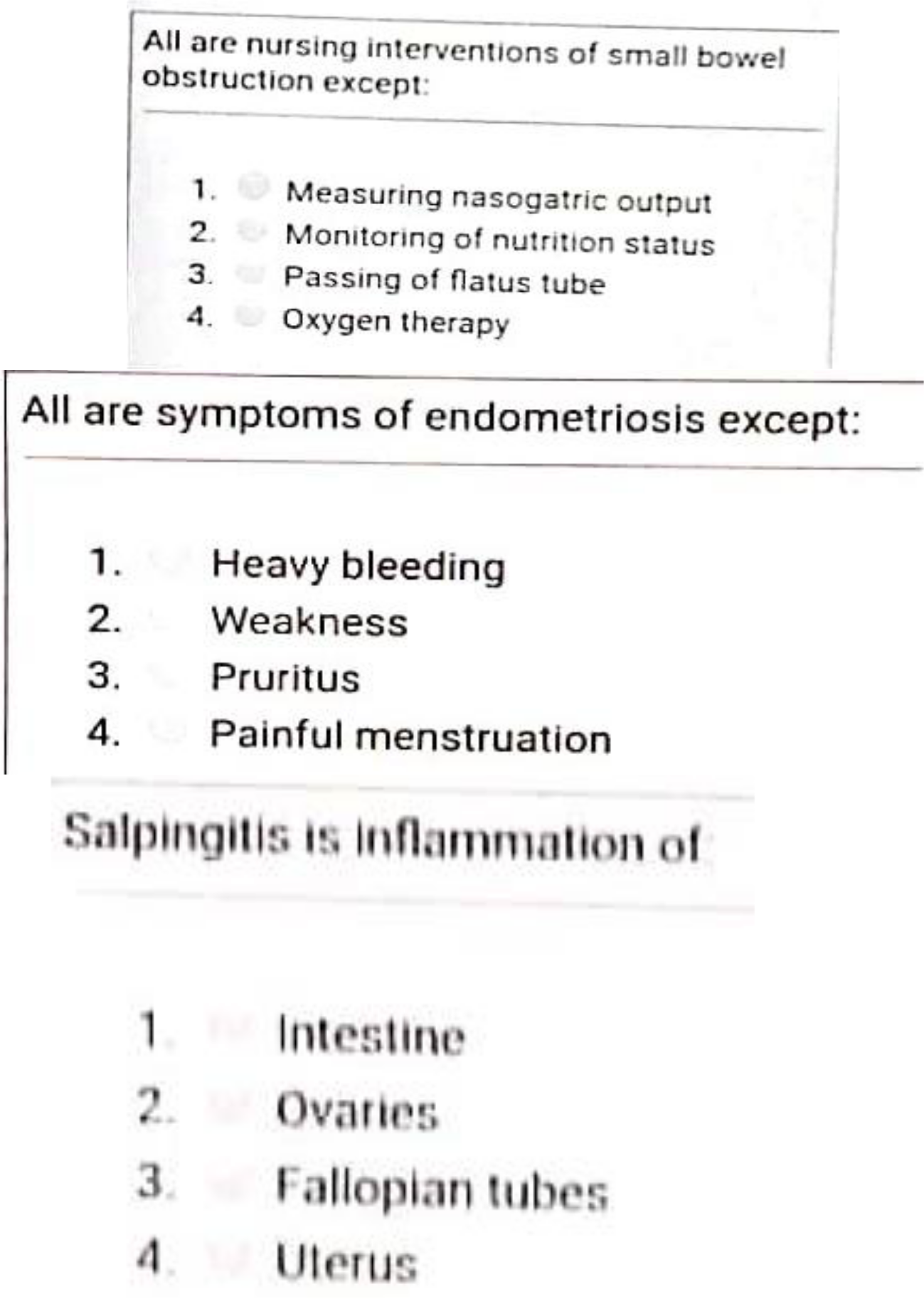
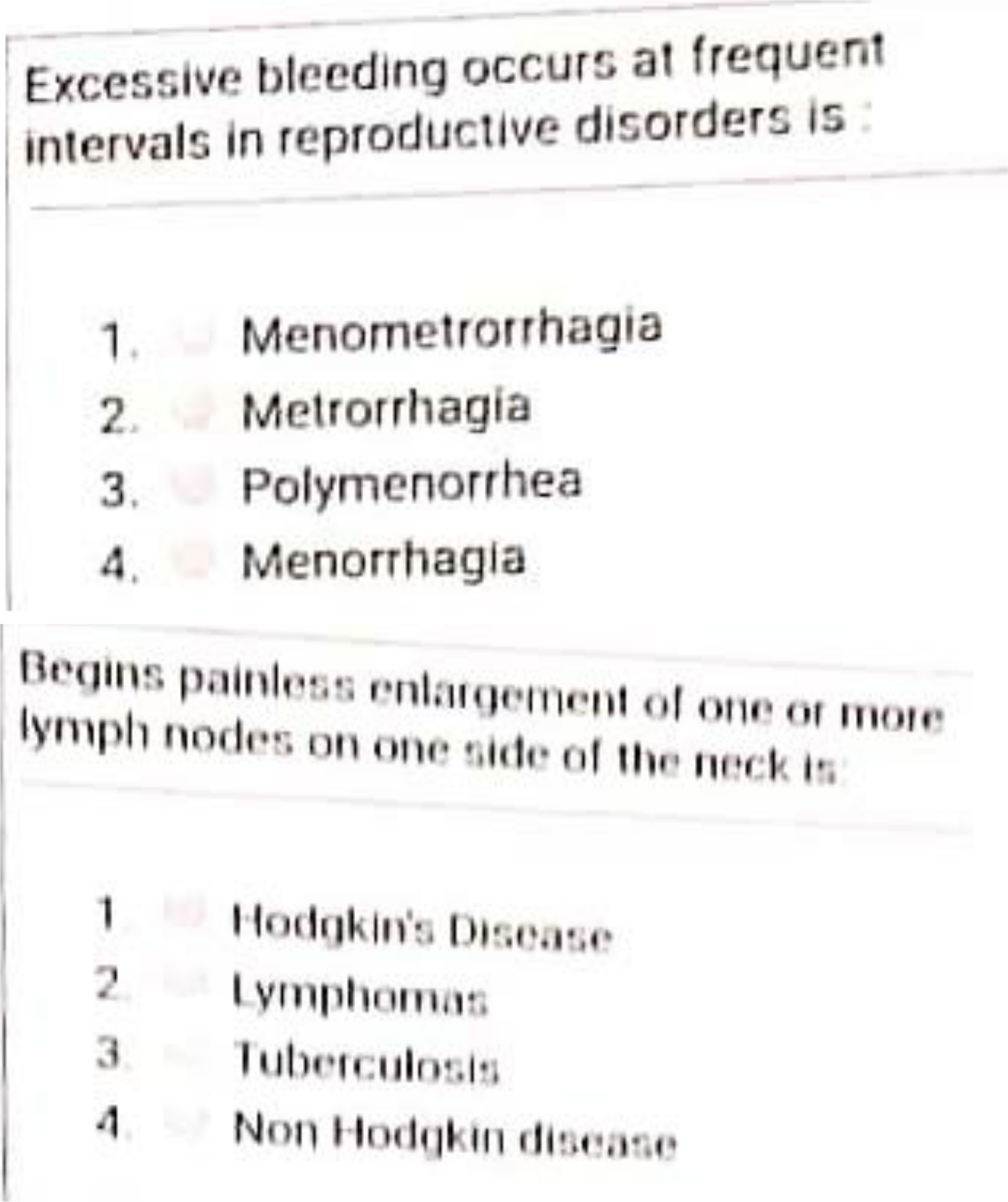
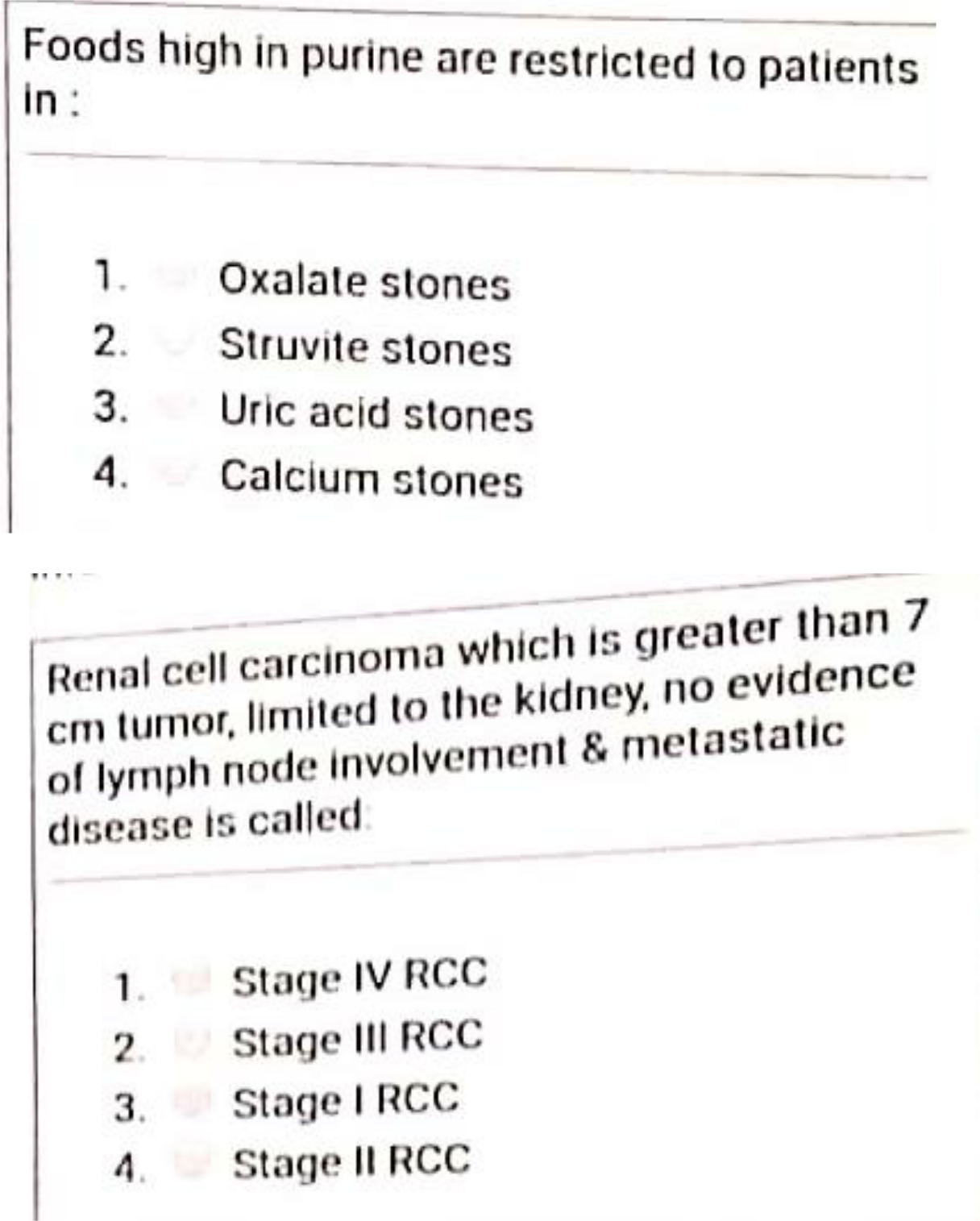
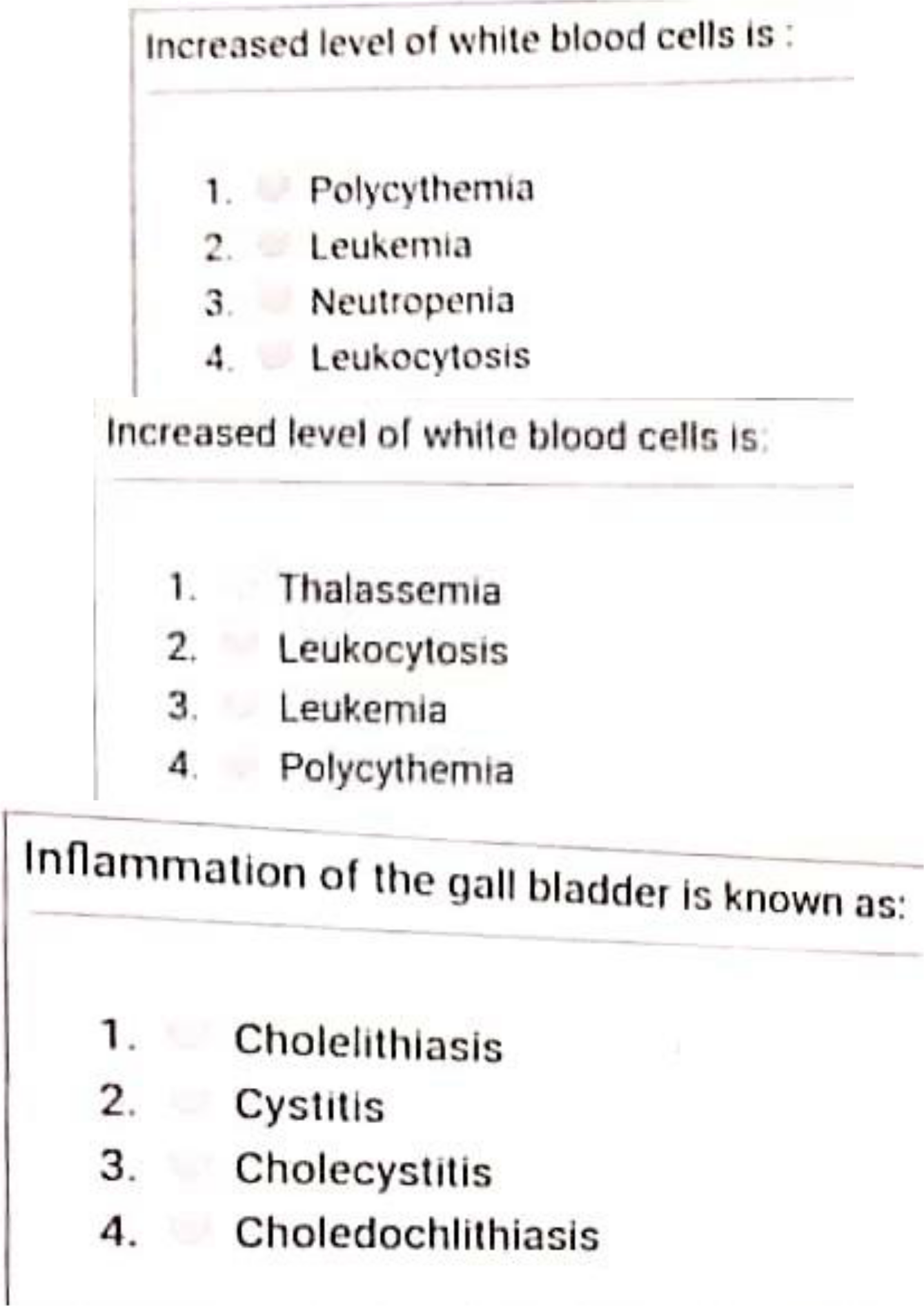
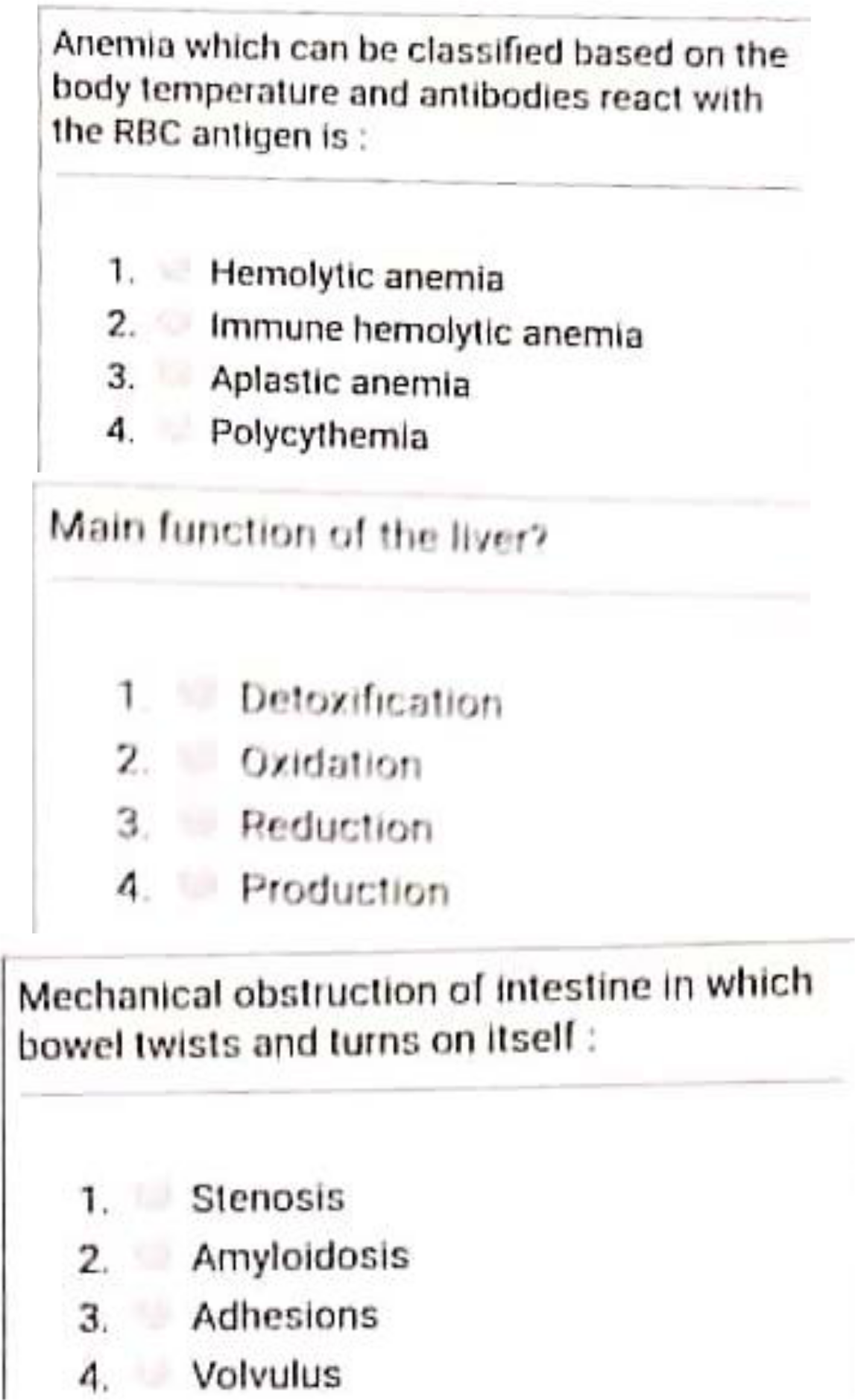





























1) It is clinical condition in which the arterial PH is greater then 7.45 PaCO3 is less then 38 mmHg.
A. Respiratory distress
B. Alkalosis & Acidosis
C. Respiratory acidosis
D. Respiratory alkalosis
2) Which nursing diagnosis is most applicable to client with fecal incontinences?
A. Risk for deficient fluid volume
B. Disturbed body image
C. Bowel incontinence
D. Altered nutrition: more than body requirement
3) Cystitis is a type of urinary tract infection of:
A. Uncomplicated lower or upper UTI
B. Upper UTI
C. Complicated lower or upper UTI
D. Lower UTI
4) When counseling a client in ways to prevent cholecystitis, which of the following guidelines is most important?
A. Eat a low-fat low cholesterol diet
B. Limit exercise to 10 minutes/day
C. Keep weight proportionate to height
D. Eat a low-protein diet
5) % of abortion in the first 12 weeks of pregnancy result from chromosomal abnormalities:
A. 50 to 80
B. 20 to 30
C. 30 to 40
D. 40 to 45
6) The patient should be setting when deep breating and coughing because this position:
A. Loosens respiratory secretions
B. Helps the patient to support their incision wiht a pillow
C. Allows the patient to observe their area and relex
D. Is physically more comfortable for the patient
7) Five minutes after the client’s first post operative exercise, the client’s vital sign have not yet return to baseline. Which is an appropriate nursing diagnosis:
A. Alteration in comfort
B. Risk for activity intolerance
C. Impaired physical mobility
D. Risk for discuss syndrome
8) The doctor has ordered 500 mg of a medication po once a day. The tablets on hand are labeled as 1 tablet = 250 mg. How many tablets will you administer to your patient?
A. 03 Tablets
B. 1 Tablets
C. 02 Tablets
D. 04 Tablets
9) Foods high in purine are restricted to patients in:
A. Calcium stones
B. Oxalate stones
C. Uric acid stones
D. Struvite stones
10) What is/are the most common cause(s) of chronic liver disease?
A. Obesity
B. Bacteria
C. Gall bladder stones
D. Alcohol abuse
11) Inflammation of the lower end of the esophagus leading to a back flow of gastric juices is called:
A. Structural abnormalities
B. Lactose intolerance
C. Acid reflux
D. Reflux esophagitis
12) Which statement about appendicitis is accurate and true?
A. Mc Burney’s point tenderness is suggestive of appendicitis
B. Lefty lower quadrant pain is suggestive of a appendicitis
C. Appendicitis is more common among females than males
D. A high fiber diet is a risk factor associated with appendicitis
13) Renal cell carcinoma which is greater than 7 cm tumor limited to the kidney, no evidence of lymph node involvement & metastatic disease is called:
A. Stage II RCC
B. Stage I RCC
C. Stage IV RCC
D. Stage III RCC
14) Excessive bleeding occurs at frequent intervals in reproductive disorders is:
A. Menometrorrhagia
B. Menorrhagia
C. Polymenorrhea
D. Metrorrhagia
15) A hernia is the of an organ or tissue out of the body cavity in which it is normally found:
A. Trauma
B. Syndrome
C. Protrusion
D. Pressure
16) Swelling of the salivary glands in mumps is called:
A. Periodontitis
B. Parotitis
C. Granuloma
D. Salivitis
17) Painless enlargement of one or more lymph nodes on one side of the neck is:
A. Tuberculosis
B. Non Hodgkin disease
C. Lymphomas
D. Hodgkin’s Disease
18) When establishing realistic goal, the nurse:
A. Bases of the goals on the narse’s personal knowledge
B. Must have the client cooperation
C. Knows the resourses of the health care facility, family and the client
D. Must have a client who is phyiscally and emotionally stable
19) Puberty age in female is:
A. 18 to 19 years
B. 19 to 20 years
C. 16 to 17 years
D. 10 to 14 years
20) A client being treated for chronic cholecystitis should be given which of the following instructions?
A. Use anti cholinergic as prescribed
B. Increase protein in diet
C. Avoid antacids
D. Increase rest
21) Which nursing diagnosis is most applicable to client with fecal incontinence?
A. Altered Nutrition:more than body requirement
B. Risk for Deficient fluid volume
C. Bowel Incontinence
D. Disturbed body image
22) What can reduce a patient’s anxiety and postsurgical pain?
A. Preoperative checklist
B. Psychological counseling
C. Preoperative teaching
D. Preoperative medication
23) A hiatus hernia occurs when the upper part of the stomach is dislocated through the hole, called a Hiatus, in the , into the chest:
A. Duodenum
B. Abdominal cavity
C. Diaphragm
D. Esophagus
24) Mechanical obstruction of intestine in which bowel twists and turns on itself:
A. Adhesions
B. Amyloidosis
C. Volvulus
D. Stenosis
25) Which electrolyte is essential for enyzme and neurological activities?
A. Magnesium
B. Phosphate
C. Potassium
D. Chloride
26) Which of the following stage the carcinogen is irreversible?
A. Progression stage
B. Promotion stage
C. Initiation
D. Regression
27) From the following nursing diagnosis which is suitable for hemorrhoids:
A. Urinary retention related to postoperative reflux spasm and fear of pain
B. Imbalance nutrition less than body requirement
C. Anxity related to surgical intervention
D. Constipation related to ignoring the urge to defecate because of pain during elimination
28) Which one is the best investigation to find out the stone in urinary tract:
A. Ultrasound
B. M.R.I
C. I.V.P
D. CT scan
29) Which is the most common complication of peptic ulcer disease?
A. Haemorrhage
B. Penetration
C. Gastric outlet obstruction
D. Perforation
30) In what order should one perform an abdominal assessment:
A. Inspection, percussion, palpitation, auscultation
B. Inspection, auscultation, percussion, palpitation
C. Percussion, Palpitation, Inspection, Auscultation
D. Palpitation, Inspection, Percussion,. auscultation
31) From the following in which operation patient needs sitz bath:
A. Appendectomy
B. Colostomy
C. Hysterectomy
D. Hemorrhoids
32) Food poisoning “should be suspected with persons who shared food within the previous 1-6 hours, and symptoms of nausea, vomiting,and idarrhea, typically, this is due to:
A. Emetics
B. Infection
C. Intoxication
D. Inebrition
33) Is a malignant disorder of hemopoietic tissues, associated increased number of
leukocytosis in the blood:
A. Hemophilia
B. H. Influenza
C. Leukemia
D. Poly cythemia
34) is primarily a disease of children older than 2 years of age:
A. Acute glomerulonephritis
B. Nephrotic syndrome
C. Renal abscess
D. Acute pyelonephritis
35) Spread of cancer cells from the primary tumor to distant sites:
A. Dysplasia
B. Metaplasia
C. Malignant
D. Metastasis
36) What intervention is the best relieve constipation during pregnancy?
A. Lying flat on back when sleeping
B. Taking a mild over-the counter laxative
C. Reduction of iron intake by half or more
D. Increasing the consumption of fruits and vegetable
37) Anemia which can be classified based on the body temperature and antibodies react with the RBC antigen is:
A. Polycythemia
B. Aplastic anemia
C. Immune hemolytic anemia
D. Hemolytic anemia
38) is disorder in which bone lose density and become porous and fragile:
A. Menarche
B. Osteoporoses
C. Formix
D. Dysmenoria
39) The most appropriate tool in confirmation of malignancy in the patient is:
A. History
B. Physical examination
C. Blood CP
D. Biopsy of tissue
40) Normal Glomerular filtration rate (GFR) per minute is:
A. 115 ml
B. 100 ml
C. 105 ml
D. 120 ml
1) When doing an assessment on a client’s eyes the very first thing that a nurse should look at is?
A. Eye internal structures
B. Eye external structures
C. The pupils reactivity to light
D. Color of the irises of the eye
2) While the nurse is inspecting the throat of a client with a tongue blade, the client begins to gag. What does this response indicate to the nurse?
A. The client is nauseated.
B. The client has nerve damage to his tongue.
C. The client has a functioning response.
D. The client has a malfunctioning response
3) During the health history, a client begins to talk about her dog and the trouble she is having housebreaking the new pet. To help the client return to the health interview, the nurse could use the communication skill:
A. Listening
B. Reflecting
C. Questioning
D. Focusing
4) After inspecting a client’s abdomen, which assessment technique should the nurse use next ?
A. Light Palpation
B. Percussion
C. Auscultation
D. Deep Palpation
5) Nurse Tara asks her client Farhan to clench his jaw as she continues to palpate his head. When she asks him to do this what is Nurse Tara most likely trying to palpate?
A. Faran’s submandibular joint
B. Farhan’s submental joint
C. Farhan’s temporomandibular joint
D. Faran’s temporal artery
6) The nurse is planning to palpate a client’s bladder. Which area of the abdomen should this palpation be done?
A. Hypogastric region
B. Right hypochondriac region
C. Right Lower Quadrant
D. Left lumbar region
7) A 70-year-old male client comes into the clinic with weight loss and difficulty swallowing. Which of the following should the nurse document for this client?
A. Odynophagia
B. Bulimia
C. Dysphagia
D. Aphasia
8) A 15-year-old high school student came to the clinic with a 1-day history of nausea and anorexia. He describes the pain as generalized yesterday, but today it has localized to the right lower quadrant. You palpate the left lower quadrant and the patient experiences pain in the right lower quadrant. What is the name of this sign?
A. Murphy’s sign
B. Psoas sign
C. Grey Turner’s sign
D. Rovsing’s sign
9) During eye assessment when you asked the patient to follow your finger or pencil as you move it in toward the bridge of the nose. Which of the following test you are performing?
A. Visual acuity
B. Visual Fields by Confrontation
C. Test for convergence
D. Visual fields
10) A nurse doing her assessment proceeds to palpate a client’s frontal and maxillary sinuses. What should she make sure she checks for?
A. Tactile signs of carcinoma
B. Swelling
C. Lesions
D. Tenderness
11) A nurse would use either a Snelling chart or the finger wiggle test to assess a client’s what?
A. Hearing
B. Vision
C. Consensual light reflex
D. Bone conduction
12 ) During assessment of pharynx you as the client to say “Ah” and uvula and soft palate rise centrally. It determine the function of which cranial nerve:
A. Spinal accessory
B. Vagus
C. Trochlear
D. Trigeminal
13) During the assessment of a client, the nurse gently touches the tip of a sterile cotton swab in the client’s eye. Which of the following would be considered an expected response for the client to make?
A. Begin sneezing.
B. Blink.
C. Scream in pain.
D. Swat the nurse’s hand away.
14) If assessing a client for kidney tenderness, where would you begin?
A. External Oblique Angle
B. Left Upper Quadrant
C. Right Upper Quadrant
D. Costovertebral Angle
15) The three things a nurse needs to check for when doing an examination on the eyes regarding the external structures is?
A. Eyelash texture, shape of eyes, redness
B. Shape of eyes, pupils reactivity, iris’s color
C. Drainage, possible tumors, irritation
D. Eyelash distribution, coloring, drainage
16) A 40-year-old female came for evaluation of abdominal pain. She stated that it is worse after eating, especially if she has a meal that is spicy or high in fat. She has taken antacids, but they have not helped the pain. After examining her abdomen, you strongly suspect cholecystitis. Which sign on examination increases your suspicion for this diagnosis?
A. Murphy’s sign
B. Psoas sign
C. Grey Turner’s sign
D. Rovsing’s sign
17) During the percussion of a client’s abdomen, the nurse hears a loud high-pitched drum like tone. The nurse would document this sound as being:
A. Resonance
B. Tympany
C. Hyper-resonance
D. Flatness
18) What could the nurse assess based solely on the way the client walks into the room?
A. Signs of illness, well nourished
B. Dress and signs of illness
C. Gender and age
D. Gait and posture
19) Which of the following is a clinical manifestation of Bell’s palsy?
A. Asymmetry of the mouth
B. Asymmetry of the entire side of the face
C. Asymmetry of the lower face
D. Involuntary movements of the face
20) The nurse notices that a client walks with a limp and has long legs. Which of the following aspects of the general survey is this nurse assessing?
A. Physical appearance
B. Behavior
C. Mental status
D. Mobility
21) Test for shifting dullness is performed to assess:
A. Liver abscess
B. Ascites
C. Cholecystitis
D. Peritonitis
22) When a nurse performing the eye examinations, which piece of equipment does she/he use to inspect the eye structures?
A. Ultrasonic stethoscope
B. Sphygmomanometer
C. Ophthalmoscope
D. Otoscope
23) The normal liver span of an adult is:
A. 7-12 cm
B. 5-12 cm
C. 6-12 cm
D. 4-12 cm
24) A client comes into the clinic for a routine breast and axilla exam. Which assessment technique does the nurse use first during this examination?
A. Palpation
B. Auscultation
C. Inspection
D. Percussion
25) The clinic is sponsoring a client education session for breast cancer awareness month. Which of the following considerations should be included to support cultural differences about breast health?
A. a. Refer all clients to the American Cancer Society if they have questions.
B. b. Inform all about the low-cost breast cancer screening program…
C. A:
D. c. Encourage all females to increase their intake of vitamins A and E
26) Grade +2 pitting edema is:
A. 4 mm deep
B. 6 mm deep
C. 2 mm deep
D. 8 mm deep
27) The nurse is going to assess a client’s blood pressure. To do this, the nurse will need to have:
A. A stethoscope and sphygmomanometer
B. A tongue blade and tuning fork
C. A flashlight and gloves
D. A stethoscope and thermometer
28) The clinic is sponsoring a client education session for breast cancer awareness month. Which of the following considerations should be included to support cultural differences about breast health?
A. Refer all clients to the American Cancer Society if they have questions.
B. Encourage all females to increase their intake of vitamins A and E.
C. Inform all about the low-cost breast cancer screening program.
D. Encourage all females to complete monthly breast exams
29) After auscultating the bowel sounds of a client, the nurse realizes the sounds were long. Which of the following would be appropriate for the nurse to use to document this finding?
A. Intensity
B. Pitch
C. Quality
D. Duration
30) During the physical assessment of Mr. Ahsan’s skin, the nurse observed that Mr. Ahsan’s skin color is pale, the nurse expect that Mr. Ahsan may has:
A. Jaundice
B. Anemia
C. Heart failure
D. Pulmonary edema
31) The nurse assesses a client’s vision to be 20/150. The client asks for an explanation of the numbers. Which of the following would be a correct explanation for the nurse to say to the client?
A. You might need surgery to correct the nystagmus
B. You see at 20 feet what a person with normal vision sees at 150 feet.
C. You see at 150 feet what a person with normal vision sees at 20 feet.
D. You have impaired vision
32) A nurse conducting an assessment on a client’s head would do what first?
A. Inspect and palpate hair
B. Look at patient’s prior medical history
C. Inspect and palpate scalp
D. Inspect and palpate sinuses to control spread of germs
33) The nurse is planning to assess the abdomen of an adult male.
A. Place the client in side-lying position
B. Ask client to empty bladder
C. Tell client to raise arms above the head
D. Ask client to hold his breath for a few seconds
34) Normal angle at nail base is:
A. 10 degrees
B. 160 degrees
C. 180 degrees
D. 30 degrees
35) When performing an ear assessment, the nurse notes tenderness of the pinna and tragus to movement and the presence of drainage in the external canal. The nurse suspects which of the following?
A. Otitis Media
B. Otitis Externa
C. An inner ear infection
D. A negative rmberg’s sign
36) The nurse asks the client to move his eyes in the shape of an H and then in a large X. The portion of the physical assessment the nurse is completing with this client is:
A. Assessing the optic nerve
B. Assessing extra ocular muscle movements
C. Assessing the eyelids
D. Assessing the red reflex
37) As the nurse introduces the otoscope into a client’s ear, the client starts to jerk his head and complains of pain. Which of the following should the nurse do?
A. Remove the otoscope and reinsert taking care not to touch the sides of the ear canal.
B. Begin to remove the embedded cerumen.
C. Instill ear drops.
D. Document “unable to complete the examination.
38) Which cranial nerve is affected by Bell’s palsy?
A. Facial (CN VII)
B. Trigeminal (CN V)
C. Vagus (X)
D. Abducens (CN VI)
39) In medical which term is used for “impaired near vision”?
A. Amblyopia
B. Myopia
C. Presbyopia
D. Diplopia
40) During the physical examination of a male client’s scrotum, the nurse palpates a mass. What should the nurse do next with this information?
A. Perform transillumination to further assess the finding.
B. Nothing. This is a normal finding.
C. Document mass palpated, left testicle.
D. Ask the client how long he’s had a tumor in his testicle.
41) During the breast exam, the nurse asks the client to raise her arms over her head. Why did the nurse change the client’s position?
A. The client has small breasts.
B. The client has large breasts.
C. The nurse couldn’t palpate the axillae correctly.
D. Skin dimpling is accented in this position
Q1) a) define Folic acid deficiency anaemia
Folate-deficiency anaemiais the lack of folic acidin the blood. Folic acidis a B vitamin that helps your body make red blood cells. If you don’t have enough red blood cells, you have anaemia. Red blood cells carry oxygen to all parts of your body.
Good sources include:
Q2) a) define renal failure
Renal failure is defined as a significant loss of renal function in both kidneys to the point where less than 10 to 20% of normal GFR remains.
| Acute renal failure | Chronic renal failure | ||
| 1) | Onset – over days to weeks Onset | 1) | Onset – over weeks to months |
| 2) | Reversibility – Invariably reversible | 2) | Usually Irreversible |
| 3) | Cause – Pre-renal or post-renal | 3) | Mostly Renal. |
| 4) | Urinary volume – Oliguria & Anuria. | 4) | Polyuria & Nocturia. |
| 5) | Renal failure casts – Absent | 5) | Renal Failure casts – Present. |
| 6) | Specific Gravity – High. | 6) | Specific Gravity – Low & fixed. |
| 7) | Past history of renal disease – Absent | 7) | Present |
| 8) | Dialysis – Required for short period | 8) | Required repeatedly. |
| 9) | Renal transplantation – Not required | 9) | Required. |
Q3) a) define leukemia
Definition It is a group of malignant disorder, affecting the blood and blood –forming tissue of the bone marrow lymph system and spleen.
Common leukemia signs and symptoms include:
Diagnosis Of Leukemia
Q4) a) define ovarian cyst
ovarian cyst
An ovarian cyst is a semi-solid or fluid-filled sac within the ovary.
Cause Ovarian Cysts
Medical Management
Surgical Management
Q5) a) define Fluid volume excess
Fluid overload or volume overload (hypervolemia) is a medical condition where there is too much fluid in the blood. Excess fluid, primarily salt and water, builds up throughout the body resulting in weight gain.
Signs of fluid overload may include:
Nursing Management of Fluid Volume Excess
Q6) a) define colorectal cancer
Colorectal canceris cancer that occurs in the colon or rectum. Sometimes it is called colon cancer
Risk factors
Nursing Management of Colorectal Cancer
1.Prevention is primary issue
2.Client teaching
3.Diet: decrease amount of fat, refined sugar, red meat; increase amount of fiber; diet high in fruits and vegetables, whole grains, legumes
4.Screening recommendations
5.Seek medical attention for bleeding and warning signs of cancer
6.Risk may be lowered by aspirin or NSAID use
Q7) write a short note on the following
1) CT scan
A computerized tomography (CT) scan combines a series of X-ray images taken from different angles around your body and uses computer processing to create cross-sectional images (slices) of the bones, blood vessels and soft tissues inside your body. CT scan images provide more-detailed information than plain X-rays do.
2) upper and lower GI endoscopies
Endoscopy is a procedure in which the gastrointestinal (GI) tract is viewed through a fiber-optic camera known as an endoscope, inserted either through the mouth (upper) to scan the oesophagus, stomach, and small intestines, or through the anus (lower) to examine the large intestine, colon and rectum.
3) ultrasound
Ultrasound is sound that travels through soft tissue and fluids, but it bounces back, or echoes, off denser surfaces. This is how it creates an image. The term “ultrasound” refers to sound with a frequency that humans cannot hear. For diagnostic uses, the ultrasound is usually between 2 and 18 megahertz (MHz).
4) barium studies
Barium studies are specialized X-ray examinations of the gastrointestinal (GI) tract such as the oesophagus, stomach, small and large intestines using a solution containing barium.
5)Biopsy (liver)
A liver biopsy is a procedure to remove a small piece of liver tissue, so it can be examined under a microscope for signs of damage or disease.
Q1) define cirrhosis of liver write its specific nursing management
Cirrhosis is a chronic progressive disease of the liver characterized by extensive degeneration and destruction of the liver parenchymal cells.
Specific Nursing Management
Nursing management for the patient with cirrhosis of the liver should focus on promoting rest, improving nutritional status, providing skin care, reducing risk of injury, and monitoring and managing complications.
Q2) define pancreatitis what are its clinical manifestations
Define pancreatitis
An inflammation of pancreas is called pancreatitis.
Clinical Manifestations
1.Pain in epigastrium region or in left upper quadrant
2.Constant pain
3.Low grade fever
4.Weight loss
5.Shock in severe condition
6.Nausea/Vomiting
7.Steatorrhea (fatty stool)
8.Decrease bowel movement
9.Breathlessness
10.Weak pulse
11.Low body temperature
12.Bluish discoloration of skin.
Q3) differentiate between peptic and duodenal ulcer
Peptic ulcers are open sores that develop on the inside lining of your stomach and the upper portion of your small intestine. The most common symptom of a peptic ulcer is stomach pain. Peptic ulcers include Gastric ulcers that occur on the inside of the stomach.
A duodenal ulcer is a peptic ulcer that develops in the first part of the small intestine (duodenum). An oesophageal ulcer occurs in the lower part of your oesophagus. Peptic ulcers are open sores that develop on the inside lining of your stomach and the upper portion of your small intestine.
Q4) define peritonitis and write its specific nursing management
Define peritonitis
An acute or chronic inflammation of peritoneum layer and peritoneal cavity.
Specific Nursing Management
1.Blood pressure monitoring
2.Medications
3.Pain management
4.I & O charting
5.Iv fluids
6.Drainage monitoring
Q5) define Iron deficiency anaemia write down its clinical manifestations and nursing management
Iron deficiency anaemia is a common type of anaemia — a condition in which blood lacks adequate healthy red blood cells. Red blood cells carry oxygen to the body’s tissues. As the name implies, iron deficiency anaemia is due to insufficient iron.
Iron deficiency anaemia signs and symptoms may include:
Nursing management
Q6) define acute renal failure write down its specific nursing management
Renal failure is defined as a significant loss of renal function in both kidneys to the point where less than 10 to 20% of normal GFR remains.
Acute Renal Failure Nursing Management:
Q7) define urinary incontinence write down its clinical manifestations
Define urinary incontinence
Urinary incontinence is the involuntary leakage of urine. It means a person urinates when they do not want to. Control over the urinary sphincter is either lost or weakened.
1.Stress incontinence:increased intra-abdominal pressure (sneezing, coughing, changing position)
2.Urge incontinence:strong urge to void that cannot be suppressed (neurological dysfunction)
3.Reflex incontinence : hyper reflex in the absence of normal sensation (spinal cord injury)
4.Overflow incontinence:over distention of the bladder (spinal cord lesions, tumours, strictures, prostatic hyperplasia.
5.Functional incontinence:cognitive impairment, Alzheimer’s disease)
6.Lactogenic incontinence: Extrinsic medical factors (alpha-adrenergic agents
7.Mixed incontinence:Combination of stress and urge incontinence
1. Bone and cartilage is a type of:
A. Nervous tissue
B. Muscular tissue
C. Epithelial tissue
D. Endocrine tissue
E. Connective tissue
2. Color of the skin, due to the presence of:
A. Collagen
B. Langerhans cells
C. Melanocytes
D. Merkel cells
E. Keratinocytes
3. Anosmia is loss of sense of
A. vision
B. hearing
C. smell
D. taste
4. The maximum volume air which can be moved into and out of the lungs is known as:
A. Total lung capacity
B. Inspiratory capacity
C. Vital capacity
D. Functional residual capacity
5. Regarding eye, sensory receptors for vision are:
A. Ciliary body
B. Rods and cones
C. Olfactory cells
D. Lens
6. The basic structure and functional unit of nervous system is:
A. Schwann Cells
B. Neurons
C. Astrocytes
D. Microglia
7. All of the following are the functions of oxytocin; except
A. Ejection of milk
B. Parturition
C. Fertilization
D. Formation of milk
8. A student identifying histological section under microscope. The tissue was multilayered. The upper most layer is squamous in shape. What type of epithelium it is?
A. Simple squamous epithelium
B. Transitional epithelium
C. Stratified squamous epithelium
D. Stratified cuboidal epithelium
E. Pseudostratified epithelium
9. Common iliac artery supplies the:
A. Lower limb
B. Abdomen
C. Thorax
D. Upper limb
E. Head and neck
10. Which of the following bone forms the axial skeleton?
A. Humerus
B. Radius
C. Femur
D. Ulna
E. Sternum
11. Center of micturition reflex is located in:
A. Lumber segment of cord
B. Cerebral cortex
C. Brainstem (pontine micturition center)
D. Sacral segment of spinal cord
A girl moves the upper limb in all directions during exercise, what type of movement she performed?
A. Abduction
B. Circumduction
C. Flexion
D. Adduction
E. Extension
12. Adrenal medulla secretes:
A. Adrenaline and noradrenaline
B. mineralocorticoid
C. Glucocorticoid
D. Androgens
13. Short bones are present in which part of the human body?
A. Palm and sole
B. Leg
C. Upper arm
D. Thigh region
E. Forearm
14. The hormone which promotes tissue growth and regulates metabolisms:
A. Aldosterone
B. Thyroid hormone
C. Prolactin
D. Growth hormone
15. Which of the following chamber of the heart contain the sinoatrial node(SA)?
A. Left atrium
B. Left auricle
C. Right atrium
D. Right ventricle
E. Left ventricle
16. The cells form the myelin sheath in the central nervous system are:
A. Ependymal cells
B. Microglial cells
C. Astrocytes
D. Oligodendrocytes
E. Schwann cells
17. Which one of the following hormone is secreted by posterior pituitary gland?
A. Growth hormone
B. Antidiuretic hormone
C. Thyroid stimulating hormone
D. Follicle stimulating hormone
18. The most common synapse in CNS is:
A. Mechanical Synapse
B. Chemical Synapse
C. Gap Junctions
D. Electrical Synapse
19. Central nervous system is made up of:
A. Peripheral nerves
B. None of these
C. Brain and spinal cord
D. Somatic nerves
20. Exchange of gases by diffusion between blood and body cells is known as:
A. Alveolar ventilation
B. Internal respiration
C. Pulmonary ventilation
D. External respiration
21. How much percentage of oxygen is transported inform of oxyhemoglobin?
A. 1.5 %
B. 60 %
C. 98.5 %
D. 40 %
22. Dorsiflexion movement occur at which of the following joint:
A. Ankle joint
B. Shoulder joint
C. Knee joint
D. Elbow joint
E. Wrist joint
23. A body is divided into anterior and posterior half by which of the following imaginary plane
A. Midsagittal plane
B. Coronal plane
C. Right median plane
D. Left median plane
E. Para-median plane
24. Which of the following bones united by the sutures?
A. Sesamoid bones
B. Skull bones
C. Long bones
D. Tarsal bones
E. Carpal bones
25. Renin is secreted by:
A. Juxtaglomerular cells(JG)
B. PCT
C. DCT
D. Vasa recta
26. Main Muscle of quiet inspiration is:
A. Internal Intercostal
B. External Intercostal
C. Diaphragm
D. Abdominals
27. Surfactant is secreted by:
A. Type I Pneumocystis
B. Goblet Cells
C. Type IV Pneumocystis
D. Type II Pneumocystis
28. Shoulder joint is a type of:
A. Cartilaginous joint
B. Syndesmosis
C. Synovial joint
D. Fibrous joint
E. Secondary cartilaginous joint
29. The release of thyroid hormones (T3 andT4) in blood is stimulated by:
A. FSH
B. ACTH
C. TSH
D. LH
30. Skin is lined by:
A. Stratified squamous epithelium
B. Cuboidal epithelium
C. Transitional epithelium
D. Pseudostratified epithelium
E. Columnar epithelium
31. Pharynx continue with the esophagus at the level of:
A. 2nd thoracic vertebra
B. 6th cervical vertebra
C. 3rd cervical vertebra
D. 2nd cervical vertebra
E. 4th cervical vertebra
32. Somatic, cutaneous senses which originates from the skin are:
A. Chemoreceptors
B. Special senses
C. Pain, touch, cold and heat
D. proprioceptors
33. Heart receives the parasympathetic supply by means of:
A. Cranial nerves
B. Vagus nerve
C. Sympathetic plexus
D. Cervical nerves
34. A student was standing in class with folding both arms which one of the following movement she did performed?
A. Medial rotation at shoulder region
B. Flexion at shoulder region
C. Extension at shoulder region
D. Circumduction at shoulder region
E. Lateral rotation at shoulder region
35. Which of the following part is not included in large intestine?
A. Cecum
B. Descending colon
C. Duodenum
D. Ascending colon
E. Transverse colon
36. System of the body which is NOT necessary for survival is:
A. Central nervous system
B. Cardiovascular system
C. Reproductive system
D. Respiratory system
37. Al are the phases of menstrual cycle except:
A. Luteal phase
B. Secretory phase
C. Menstrual phase
D. Proliferative phase
38. Superior venacava is formed by the union of:
A. Cardiac veins
B. Common iliac veins
C. Brachiocephalic veins
D. Internal jugular veins
E. Azygous veins
Answer Key
1 E
2 C
3 C
4 C
5 B
6 B
7 A
8 C
9 A
10 B
11 C
12 A
13 A
14 A
15 D
16 E
17 C
18 B
19 C
20 B
21 C
22 A
23 A
24 B
25 B
26 B
27D
28 C
29 C
30 A
31 C
32 A
33 B
34 B
35 C
36 C
37 A
38 C
What is paragraph? What are some important elements for writing a good paragraph?
A paragraph is a series of sentences that are organized and coherent, and are all related to a single topic. Almost every piece of writing you do that is longer than a few sentences should be organized into paragraphs. This is because paragraphs show a reader where the subdivisions of an essay begin and end, and thus help the reader see the organization of the essay and grasp its main points.
Paragraphs can contain many different kinds of information. A paragraph could contain a series of brief examples or a single long illustration of a general point.
Paragraph Structure/Elements
Most paragraphs in an essay have a three-part structure (Elements)—introduction, body, and conclusion. You can see this structure in paragraphs whether they are narrating, describing, comparing, contrasting, or analyzing information. Each part of the paragraph plays an important role in communicating your meaning to your reader.
Introduction: the first section of a paragraph; should include the topic sentence and any other sentences at the beginning of the paragraph that give background information or provide a transition.
Body: follows the introduction; discusses the controlling idea, using facts, arguments, analysis, examples, and other information.
Conclusion: the final section; summarizes the connections between the information discussed in the body of the paragraph and the paragraph’s controlling idea.
English- BSN (Generic)
1. Yesterday she sent ______ SMS to me.
A. A
B. All of these
C. An
D. The
2. That day he _________ do as I asked him to do.
A. Does not
B. Did not
C. would not
D. Will not
3. Where is__________ pen, I gave you yesterday?
A. this
B. a
C. the
D. an
4. Are you waiting for him __________the airport?
A. Inside
B. Onto
C. On
D. At
5. An eagle flies faster than any other bird of prey (Identify underlined phrase)
A. Pronoun
B. Interjection
C. Adjective
D. Adverb
6. They are walking ______the North.
A. Since
B. Towards
C. Under
D. On
7. He drove his car very slowly (identify the marked phrase)
A. conjunction/ adjective
B. adverb/ adverb
C. adverb/ adjective
D. adjective/ adverb
8. I have already _____________this movie, you must buy another one.
A. Watch
B. Watches
C. Watched
D. Watching
9. They have been working in Karachi_______16 years.
A. from
B. since
C. up to
D. for
10. The jet sped into the deep blue sky. (Identify underlined phrase)
A. noun
B. preposition
C. adjective
D. conjunction
E. adverb
11. ______Sun rises in ______east.
A. X/An
B. A/An
C. A/The
D. The/The
12. They will be driving______2pm____4pm.
A. from/up to
B. since/x
C. from/to
D. for/x
13. Sana has_________ her book to me to mark important chapters that may help her in her interview.
A. Given
B. Gave
C. Gives
D. Give
14. Last Tuesday it _________raining since morning.
A. had
B. had been
C. has
D. have
15. She did not _______her convocation ceremony.
A. attends
B. attend
C. attended
D. have been tending
E. attending
16. Sobia & Fehmida _______plucked many flowers four garden recently.
A. have been
B. has
C. have
D. are
17. They usually _______English in their offices thus, we don’t face problem in understanding their instructions.
A. speaking
B. spoke
C. speak
D. speaks
18. Mr. Saleem is ____lecturer in our college.
A. a
B. an
C. the
D. x
19. Why were you so angry? (Identify underlined phrase)
A. Adverb
B. Preposition
C. Pronoun
D. Adjective
20. The way he answered me was really so sweet (identify the marked phrase)
A. adjective
B. preposition
C. conjunction
D. adverb
21. You have been doing your lab work___________24 hour
A. till
B. Since
C. for
D. from
22. Last Sunday they _________me several questions before my flight to Dubai.
A. asks
B. ask
C. asked
D. asking
23. Our team has been maintaining the score ____________15 minutes and 37seconds.
A. until
B. from
C. for
D. Since
24. Your friend is really sweet (identify the underline phrase)
A. verb
B. adjective
C. adverb
D. noun
25. Did you ___________attention to the announcement?
A. Paying
B. Pay
C. Pays
D. Had paid
26. Did Ayesha call her brother yesterday? Yes, she__________
A. called
B. did not called
C. call
D. have not been calling
27. He is an intelligent but a lazy boy (identify conjunction)
A. lazy
B. intelligent
C. but
D. an
28. Farhan has gone home _______he had to leave for his job interview in the afternoon.
A. But
B. Asif
C. Because
D. Therefore
29. Ali and Ahsan have been living in Islamabad ______January.
A. from
B. up to
C. since
D. for
30. She is my ___aunty, she is very sweet:
A. the
B. none of these
C. a
D. an
31. Several planets are bigger than the earth. (Identify subject)
A. the earth
B. Several
C. Planets and earth
D. several planets
32. He is _________honest man among all.
A. The
B. A
C. All these
D. An
33. My sibling did not ____________to meet their class fellow.
A. Will go
B. Gone
C. Went
D. Go
34. She answered every question very beautifully. (Identify underlined phrase)
A. interjection
B. preposition
C. Adjective
D. adverb
35. Today Hammad ________helping his brother to complete his task.
A. has
B. is
C. were
D. will
36. Zara decided to-do ______best she could.
A. An
B. A
C. The
D. None of these
37. Next year we ___________admission in Lahore.
A. Will get
B. have got
C. got
D. will got
E. get
38. These days she is trying to _________some different research work.
A. Do
B. Doing
C. Did
D. Done
39. Salman is such a tremendous player; he is ______Shahid Afridi of our team.
A. a
B. none of these
C. an
D. the
Answer Key
BS Nursing
1. The term _____________ is applied to unwanted or discarded waste matter while refuse means the solid discarded material produced by human habitant except human excreta.
a. Wholesome Water
b. Sewage
c. Waste
d. Garbage
e. Refuse
2. Environment refers to:
a. Environ
b. Organisms
c. Living things
d. Surroundings
e. Objects
3. The abiotic components are classified as:
a. Climatic
b. Water
c. Air
d. Food
e. All of the above
4. Rural Communities are the:
a. Places outside cities
b. Places in Suburbs
c. Places in the cities
d. Places adjacent to the cities
e. Places built with the cities
5. _______________ is a state of poor health:
a. Wellness
b. Illness
c. Wellbeing
d. Disease
e. Ill Health
6 ______________ are places inside of the cities:
a. Urban Communities
b. Rural Communities
c. Mauhalla
d. Suburbs
e. Towns
7. The most polluted form of water is:
a. River water
b. Springs
c. Shower water
d. Surface water
e. Rain water
8. The Health Belief was a psychological model developed by:
a. Julian Anderson
b. Neil Harmor
c. Florence Nightangle
d. Adam Jenner
e. Rosenstock
9. Cultural environment include all except:
a. Society
b. Economy
c. Microbia
d. Economics
e. Politics
10. The term Anthrosphere refers:
a. Flora
b. Natural disasters
c. Man made things
d. Fauna
e. Air
11. Fauna is:
a. Lithosphere
b. Atmosphere
c. Transformers
d. Hydrosphere
e. Biosphere
12. __________________________ on the other hand refers to those interventions that take place in a hospital setting such as intravenous rehydration or surgery
a. Tertiary Health Care
b. Primary Health Care
c. Bedside care
d. Secondary Health Care
e. Primitive Health Care
13. The main objectives of Community Health Nursing are optimum individual, and
a. Secondary Health Care
b. Primitive Health Care
c. National Health
d. Community health.
e. Primary Health
14. __________________refers to contaminants that enter a waterway through a discrete conveyance, such as a pipe.
a. Non Point source Pollution
b. Point source pollution
c. Water pollution
d. Food pollution
e. Sewage pollution
15. Surface water is usually:
a. Hard in nature
b. Neutral in Nature
c. Acidic in Nature
d. Soft in Nature
e. Alkaline in Nature
16. Is the intentional movement of _____________from outside a building to the inside.
a. Air
b. Water
c. Soil
d. Food
e. Pollution
17. Absence of fresh air can cause:
a. Heartburn
b. Diabetese
c. Headache
d. Constipation
e. Iron deficiency Anemia
18. Balanced Diet is best defined as :
a. Diet that satisfies your hunger
b. Diet that contains the optimum requirement of food calories and the nutrients.
c. Diet Rich in Fructose
d. Diet rich in Fats and Carbohydrates.
e. Diet rich in Sugar
19. The example of liquid waste is:
a. Plastics,
b. Styrofoam containers
c. Scrap Iron
d. Bleach
e. Chemicals
20. Dumping is the method of waste refusal in which :
a. In costal towns refuse is carried 15 miles within sea and is dumped there
b. In costal towns refuse is carried 5 miles within sea and is dumped there
c. In costal towns refuse is carried 50 miles within sea and is dumped there
d. In costal towns refuse is carried 25 miles within sea and is dumped there
e. In costal towns refuse is carried 0.5 miles within sea and is dumped there
21. ________________ is a modified sanitary landfill. Here mixed refuse should be placed properly and covered by earth.
a. Composting
b. Incineration
c. Controlled Tipping
d. Slow Sand Filter Bed
e. Rapid Sand Filteration Bed
22. The end product, ________________, contains few or no disease producing organisms, and is a good soil builder containing small amounts of the major plant nutrients such as nitrates and phosphates
a. Compost
b. Sudge
c. Sludge
d. Siners
e. Incliners
23. The heat produced during composting, is _______________ or higher
a. 61OC
b. 62OC
c. 64OC
d. 60OC
e. 630C
24. In Bangalore Method the first layer of refuse is about __________ thick
a. 20 cm
b. 10 cm
c. 15 cm
d. 16 cm
e. 17 cm
25. Mechanical Composting is also known as :
a. Anaerobic Method
b. Old Method
c. New Method
d. Aerobic method
e. Refined Method
26. One of the disease caused by rodent is:
a. Whooping Cough
b. Plague
c. Tuberculosis
d. Diabetes
e. Angina Pectoris
27. Plague is caused by Bacteria
a. Yersinia Spirochetes
b. Yersinia Meningococal
c. Yersinia Pestis
d. Yersinia Anopheles
e. Yersinia Ameobic
28. Bubo is formed in
a. Toxoplasmosis
b. Plague
c. Hypertension
d. Pneumonic plague
e. Bubonic Plague
29. Slaughter house is also known as:
a. Private Abattoir
b. Public Abattoir
c. Public Savege house
d. Public Slaughter House
e. Private Slaughter House
30. Animal infections transmitted to man by meat are called
a. Exogenoses Contamination
b. Exogenous Contamination
c. Endogenoses Contamination
d. False Contamination
e. Zoonoses Contamination
Answer key
1. C
2. D
3. A
4. A
5. E
6. A
7. A
8. E
9. C
10. C
11. E
12. A
13. D
14. B
15. C
16. A
17. C
18. B
19. E
20. B
21. C
22. A
23. D
24. C
25. D
26. B
27. C
28. E
29. B
30. E
BS Nursing
1. Sickness is:
A. A social state, signifying an impaired role for those who are ill.
B. A phenomenon in which one or more natural functions of the body are so disturbed
C. A condition of body or some part or organ of body in which its functions are unbalanced.
D. A state in which the individual has no health problem
2. Following are the functions of Pakistan Nursing Council (PNC) except:
A. PNC works closely with the four provincial Nursing Examination Boards (NEBs)
B. PNC inspects educational institutions for approval based on established standards.
C. PNC provides registration (license) to practice to doctors
D. PNC Maintains standards of education and practice
E. PNC sets the curriculum for the education of Nurses, Midwives, LHVs and Nursing Auxiliaries
3. Which of the following is the social environmental need for normal physical and mental health?
A. All of the above
B. Good nutrition and proper rest
C. Regular exercise and recreations
D. Work in accordance with health conditions
4. International conference (Alma Ata) on primary health care was held form _______ in Alma Ata, USSR:
A. September 6-12, 1979
B. September 6-12, 1978
C. September 6-12, 1977
D. September 6-12, 1976
5. Determinants of community health include:
A. Equitable distribution
B. Environment
C. Rehabilitation
D. Treatment of disorders
6. ___________________ is a geographic area that is located outside towns and cities.
A. Rural area or countryside community
B. Suburban community
C. Urban community
D. Rural and urban community
E. Community
7. ___________________ can be define as a phenomenon in which one or more natural functions of the body are so disturbed.
A. Infection
B. Disease
C. Illness
D. Sickness
8. According to American Nurses Association _____________ is “a synthesis of nursing and public health practice applied to promoting and preserving the health populations”:
A. Community health
B. Community
C. Public health
D. Community health nursing
9. The ____________ is the most popularly used method of waste disposal used today:
A. All of the above
B. Recycling
C. Disposal in ocean/sea
D. Landfill
E. Incineration/combustion
10. Which one of the following is NOT included in the elements of primary health care (PHC):
A. Provision of safe water and basic sanitation
B. Safe food supply and proper nutrition
C. Appropriate treatment of common diseases and injuries
D. Increasing the adaptation of the individual to his environment
11. A group of people living in the same place or having a particular characteristic in common is:
A. City
B. Community
C. Town
D. Society
E. Provence
12. Basic principles of primary health care include:
A. Contributing to method of diagnosis
B. Prevention and control of non-communicable diseases
C. Decentralization of power
D. Reproductive health needs
13. Following are the components of health education except:
A. Environmental health
B. Emotional health
C. Physical health
D. Infirmity
E. Social health
14. International conference (Alma Ata) on primary health care was held at USST capital of:
A. Waziristan
B. Turkistan
C. Afghanistan
D. Kazakhstan
15. Safe food supply and proper nutrition is:
A. Essentials/Elements of primary health care
B. Goal and objective of primary health care
C. Basic requirement of primary health care
D. Basic principle of primary health care
16. __________________ is barrier to community/ public participation
A. Lack of education or information
B. Poverty/socioeconomic status
C. Cultural minorities
D. Negligence from government
17. A basic health unit (BHU) is for the population of:
A. 4000-11000
B. 3000-4000
C. 5000-10000
D. 15000- 20000
18. Education that promotes an understanding of how to maintain personal health is:
A. Health education
B. Education
C. Learning
D. Community health education
E. Teaching
19. Which of the one the following is characteristics of community health nursing?
A. Increase the average life expectancy
B. Emphasizes wellness rather than illness
C. Decreasing the morbidity rate
D. Providing total health care to improve quality of life
20. An average person must sleep for ____________ hours during night:
A. 4 to 8
B. 6 to 8
C. 7 to 8
D. 5 to 8
21. PHC based on the following principles except:
A. Nation-wide coverage
B. Inter-sectoral coordination
C. Self-reliance
D. Social equity
E. Self-actualization
22. Which is the primary goal of community health nursing?
A. To contribute to national development through promotion of family welfare, focusing particularly on mothers and children
B. To support and supplement the efforts of the medical profession in the promotion of health and prevention of illness
C. To increase the productivity of the people by providing them with services that will increase their level of health
D. To enhance the capacity of individuals, Families and communities to cope with their health needs.
23. Which one of the following is subjective component of wellness?
A. Level of provision of recreational; services
B. Individuals own evaluation of standard of life
C. Level of provision of health services
D. Occupation and employment status
24. Supervises the work of health assistants in district is responsibility of:
A. District health nurse
B. Executive district health officer
C. District health inspector
D. District health officer
25. ______________________ can be defined as a phenomenon in which one or more natural functions of the body are so disturbed.
A. Infection
B. Disease
C. Illness
D. Sickness
26. The Pakistan Nursing Council (PNC) is a regulatory body established in:
A. 1947
B. 1950
C. 1951
D. 1949
E. 1948
27. Devolution of power in health departments:
A. Improve the quantity and quality of health care delivery to the people close to their door step
B. Reproductive health
C. Food sanitation
D. Prevent and control communicable diseases
E. Occupational health
28. Chloramines in the water, like dichloramine and trichloramine, irritate and causes all except one:
A. Heart problem
B. Eye problems
C. Nose problems
D. Skin problems
E. Ear problems
Answer KEY
1. A
2. C
3. A
4. B
5. B
6. A
7. C
8. D
9. D
10. D
11. B
12. B
13. D
14. D
15. A
16. A
17. D
18. A
19. D
20. B
21. E
22. D
23. B
24. D
25. C
26. F
27. A
28. E